Motorola Mobility T56FK1 Portable Cellular / PCS GSM Transceiver User Manual Exhibit 8 Users Manual
Motorola Mobility LLC Portable Cellular / PCS GSM Transceiver Exhibit 8 Users Manual
Exhibit 8 Users Manual
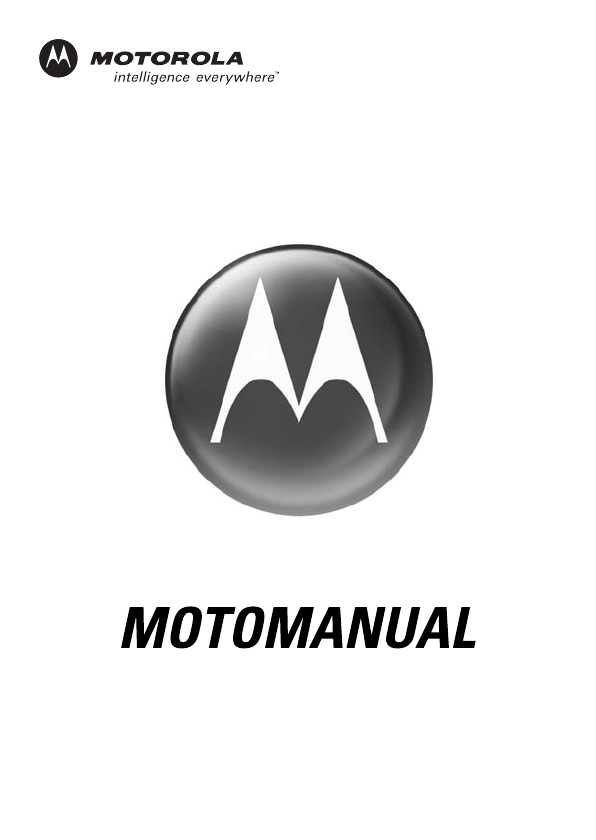
V560
GSM
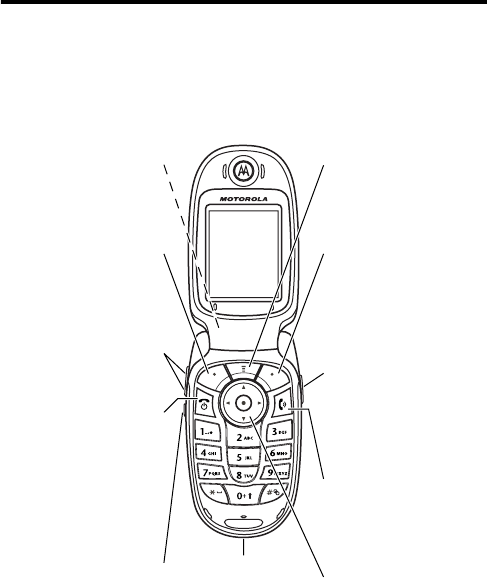
DRAFT
1
Welcome
Welcome to the world of Motorola digital wireless
communications! We are pleased that you have chosen the
Motorola V560 GSM wireless phone.
Left Soft Key
Perform function
in lower left
display.
Voice Key
Create voice
records & voice
dial names.
Headset Jack
Volume Keys
Smart Key 5-Way Navigation
Key with Center
Select
Menu Key
Right Soft Key
Perform function
in lower right
display.
Power & End Key
Turn phone
on/off, end calls,
exit menu
system.
Accessory
Connector Port
Insert charger
& phone
accessories.
Send Key
Make & answer
calls.
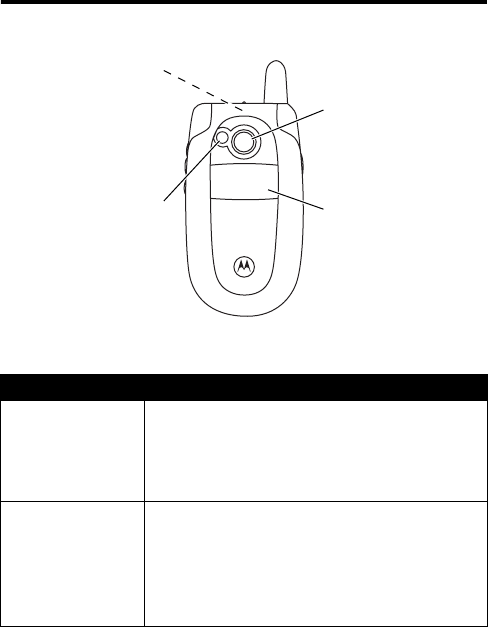
DRAFT
2
Check It Out!
Feature Description
Connect to a
Personal Area
Network
Pair your phone with an access point for
a personal area network:
M
>
Settings
>
Connection
>
Bluetooth Link
>
Access Points
>
[Look For Devices]
Bluetooth®
Wireless
Pairing
Pair your phone with a Bluetooth
®
headset, car kit, or computer:
M
>
Settings
>
Connection
>
Bluetooth Link
>
Setup
>
Power
>
On
, press
BACK
(
-
),
press >
Handsfree
>
[Look For Devices]
Camera Lens
Record video
clips & take
photos.
Handsfree
Speaker
(on back of
phone)
External Display
View incoming
call information.
Mirror
Aim camera lens
for self portraits.

DRAFT
3
Record Video
Clip
Record a video clip:
Press
M
>
Multimedia
>
Videos
>
[New Video]
, point lens at subject, press
CAPTURE
(
+
) to begin recording, press
STOP
(
+
) to stop recording.
Play Video
Clip
Play a video clip:
M
>
Multimedia
>
Videos
> video clip
Take Photo
Press
M
>
Multimedia
>
Camera
, point lens
at subject, press
CAPTURE
(
+
) to take a
photo.
Send Photo
Send a photo to a phone number or
email address:
Take photo, then press
STORE
(
+
)
>
Send In Message
.
Set Photo as
Picture ID
Assign a photo to a phonebook entry to
allow picture caller ID:
Take photo, then press
STORE
(
+
)
>
Apply as Phonebook Entry
.
Send
Multimedia
Message
Send a multimedia message
with pictures, animations,
sounds, and videos:
M
>
Messages
>
Create Message
>
New Multimedia Msg
Feature Description
032380o
DRAFT
4
Motorola, Inc.
Consumer Advocacy Office
1307 East Algonquin Road
Schaumburg, IL 60196
www.hellomoto.com
1-800-331-6456 (United States)
1-888-390-6456 (TTY/TDD United States for hearing impaired)
1-800-461-4575 (Canada)
MOTOROLA and the Stylized M Logo are registered in the US Patent &
Trademark Office. The Bluetooth trademarks are owned by their proprietor and
used by Motorola, Inc. under license. Java and all other Java-based marks are
trademarks or registered trademarks of Sun Microsystems, Inc. in the U.S. and
other countries. All other product or service names are the property of their
respective owners.
©
Motorola, Inc. 2004, 2005.
Caution:
Changes or modifications made in the radio phone, not expressly
approved by Motorola, will void the user’s authority to operate the equipment.
Software Copyright Notice
The Motorola products described in this manual may include copyrighted
Motorola and third-party software stored in semiconductor memories or other
media. Laws in the United States and other countries preserve for Motorola
and third-party software providers certain exclusive rights for copyrighted
software, such as the exclusive rights to distribute or reproduce the copyrighted
software. Accordingly, any copyrighted software contained in the Motorola
products may not be modified, reverse-engineered, distributed, or reproduced
in any manner to the extent allowed by law. Furthermore, the purchase of the
Motorola products shall not be deemed to grant either directly or by implication,
estoppel, or otherwise, any license under the copyrights, patents, or patent
applications of Motorola or any third-party software provider, except for the
normal, non-exclusive, royalty-free license to use that arises by operation of
law in the sale of a product.
Manual number: 68XXXXXX95-O

DRAFT
5
Contents
Safety and General Information
. . . . . . . . . . . . . . . . . . . . 8
European Union Directives Conformance Statement
. . 15
Caring for the Environment by Recycling
. . . . . . . . . . . 16
Getting Started
. . . . . . . . . . . . . . . . . . . . . . . . . . . . . . . . . 17
About This Guide . . . . . . . . . . . . . . . . . . . . . . . . . . . . . . 17
Installing the SIM Card . . . . . . . . . . . . . . . . . . . . . . . . . . 18
Battery Tips . . . . . . . . . . . . . . . . . . . . . . . . . . . . . . . . . . 19
Installing the Battery . . . . . . . . . . . . . . . . . . . . . . . . . . . . 21
Charging the Battery. . . . . . . . . . . . . . . . . . . . . . . . . . . . 22
Turning Your Phone On. . . . . . . . . . . . . . . . . . . . . . . . . . 23
Turning Your Phone Off. . . . . . . . . . . . . . . . . . . . . . . . . . 23
Adjusting Volume . . . . . . . . . . . . . . . . . . . . . . . . . . . . . . 24
Making a Call . . . . . . . . . . . . . . . . . . . . . . . . . . . . . . . . . 24
Answering a Call. . . . . . . . . . . . . . . . . . . . . . . . . . . . . . . 25
Viewing Your Phone Number . . . . . . . . . . . . . . . . . . . . . 25
Highlight Features
. . . . . . . . . . . . . . . . . . . . . . . . . . . . . . 26
Using a Personal Area Network . . . . . . . . . . . . . . . . . . . 26
Recording and Playing Video Clips . . . . . . . . . . . . . . . . 29
Taking and Sending a Photo. . . . . . . . . . . . . . . . . . . . . . 34
Sending a Multimedia Message . . . . . . . . . . . . . . . . . . . 36
Using Bluetooth® Wireless Pairing. . . . . . . . . . . . . . . . . 40
Learning to Use Your Phone
. . . . . . . . . . . . . . . . . . . . . . 45
Using the Display . . . . . . . . . . . . . . . . . . . . . . . . . . . . . . 45
Using the 5-Way Navigation Key. . . . . . . . . . . . . . . . . . . 50
Using Menus. . . . . . . . . . . . . . . . . . . . . . . . . . . . . . . . . . 51
Entering Text. . . . . . . . . . . . . . . . . . . . . . . . . . . . . . . . . . 53
Using the Smart Key. . . . . . . . . . . . . . . . . . . . . . . . . . . . 65
DRAFT
6
Using the External Display . . . . . . . . . . . . . . . . . . . . . . 65
Using the Handsfree Speaker . . . . . . . . . . . . . . . . . . . . 67
Changing a Code, PIN, or Password. . . . . . . . . . . . . . . 67
Locking and Unlocking Your Phone. . . . . . . . . . . . . . . . 68
If You Forget a Code, PIN, or Password . . . . . . . . . . . . 69
Using the Phonebook . . . . . . . . . . . . . . . . . . . . . . . . . . 70
Setting Up Your Phone
. . . . . . . . . . . . . . . . . . . . . . . . . . 73
Setting a Ring Style. . . . . . . . . . . . . . . . . . . . . . . . . . . . 73
Changing the Call Alert . . . . . . . . . . . . . . . . . . . . . . . . . 74
Setting the Time and Date . . . . . . . . . . . . . . . . . . . . . . 74
Setting a Wallpaper Image . . . . . . . . . . . . . . . . . . . . . . 75
Setting a Screen Saver Image . . . . . . . . . . . . . . . . . . . 76
Changing Phone Skin . . . . . . . . . . . . . . . . . . . . . . . . . . 77
Setting a Phone Theme . . . . . . . . . . . . . . . . . . . . . . . . 77
Setting Answer Options. . . . . . . . . . . . . . . . . . . . . . . . . 78
Setting Display Brightness . . . . . . . . . . . . . . . . . . . . . . 79
Adjusting the Backlight . . . . . . . . . . . . . . . . . . . . . . . . . 79
Setting Display Timeout . . . . . . . . . . . . . . . . . . . . . . . . 80
Storing Your Name and Phone Number . . . . . . . . . . . . 80
Calling Features
. . . . . . . . . . . . . . . . . . . . . . . . . . . . . . . 81
Turning Off a Call Alert . . . . . . . . . . . . . . . . . . . . . . . . . 81
Viewing Recent Calls . . . . . . . . . . . . . . . . . . . . . . . . . . 81
Redialing a Number . . . . . . . . . . . . . . . . . . . . . . . . . . . 83
Using Automatic Redial. . . . . . . . . . . . . . . . . . . . . . . . . 83
Returning an Unanswered Call . . . . . . . . . . . . . . . . . . . 84
Using the Notepad . . . . . . . . . . . . . . . . . . . . . . . . . . . . 84
Putting a Call On Hold or Mute . . . . . . . . . . . . . . . . . . . 85
Using Call Waiting. . . . . . . . . . . . . . . . . . . . . . . . . . . . . 86
Using Caller ID (Incoming Calls). . . . . . . . . . . . . . . . . . 86
Calling an Emergency Number . . . . . . . . . . . . . . . . . . . 87
Dialing International Numbers. . . . . . . . . . . . . . . . . . . . 87
DRAFT
7
Calling With 1-Touch Dial . . . . . . . . . . . . . . . . . . . . . . . . 88
Using Voicemail . . . . . . . . . . . . . . . . . . . . . . . . . . . . . . . 88
Changing the Active Line . . . . . . . . . . . . . . . . . . . . . . . . 90
Phone Features
. . . . . . . . . . . . . . . . . . . . . . . . . . . . . . . . 91
Main Menu . . . . . . . . . . . . . . . . . . . . . . . . . . . . . . . . . . . 91
Settings Menu. . . . . . . . . . . . . . . . . . . . . . . . . . . . . . . . . 92
Feature Quick Reference . . . . . . . . . . . . . . . . . . . . . . . . 93
Calling Features . . . . . . . . . . . . . . . . . . . . . . . . . . . . . . . 93
Messages . . . . . . . . . . . . . . . . . . . . . . . . . . . . . . . . . . . . 94
Phonebook . . . . . . . . . . . . . . . . . . . . . . . . . . . . . . . . . . . 95
Personalizing Features . . . . . . . . . . . . . . . . . . . . . . . . . . 98
Instant Messaging. . . . . . . . . . . . . . . . . . . . . . . . . . . . . 100
Chat . . . . . . . . . . . . . . . . . . . . . . . . . . . . . . . . . . . . . . . 101
Email. . . . . . . . . . . . . . . . . . . . . . . . . . . . . . . . . . . . . . . 101
Menu Features . . . . . . . . . . . . . . . . . . . . . . . . . . . . . . . 102
Special Dialing Features. . . . . . . . . . . . . . . . . . . . . . . . 103
Call Monitoring . . . . . . . . . . . . . . . . . . . . . . . . . . . . . . . 104
Handsfree Features . . . . . . . . . . . . . . . . . . . . . . . . . . . 104
Data and Fax Calls . . . . . . . . . . . . . . . . . . . . . . . . . . . . 106
Network Features . . . . . . . . . . . . . . . . . . . . . . . . . . . . . 106
Personal Organizer Features . . . . . . . . . . . . . . . . . . . . 107
Security. . . . . . . . . . . . . . . . . . . . . . . . . . . . . . . . . . . . . 109
News and Entertainment . . . . . . . . . . . . . . . . . . . . . . . 109
Troubleshooting
. . . . . . . . . . . . . . . . . . . . . . . . . . . . . . . 112
Specific Absorption Rate Data
. . . . . . . . . . . . . . . . . . . 113
Index
. . . . . . . . . . . . . . . . . . . . . . . . . . . . . . . . . . . . . . . . 115

DRAFT
8
Safety and General Information
IMPORTANT INFORMATION ON SAFE AND EFFICIENT OPERATION.
READ THIS INFORMATION BEFORE USING YOUR PHONE.
1
Exposure To Radio Frequency (RF) Energy
Your phone contains a transmitter and a receiver. When it is ON, it
receives and transmits RF energy. When you communicate with your
phone, the system handling your call controls the power level at which
your phone transmits.
Your Motorola phone is designed to comply with local regulatory
requirements in your country concerning exposure of human beings to RF
energy.
Operational Precautions
To assure optimal phone performance and make sure human exposure to
RF energy is within the guidelines set forth in the relevant standards,
always adhere to the following instructions.
External Antenna Care
If your phone has an external antenna, use only the supplied or
Motorola-approved replacement antenna. Unauthorized antennas,
modifications, or attachments could damage the phone and/or may result
in non-compliance with local regulatory requirements in your country.
Do NOT hold the external antenna when the phone is IN USE. Holding
the external antenna affects call quality and may cause the phone to
operate at a higher power level than needed.
Phone Operation
When placing or receiving a phone call, hold your phone as you would a
wireline phone.
DRAFT
9
Body-Worn Operation: Voice Communication
To maintain compliance with RF energy exposure guidelines, if you wear a
phone on your body when transmitting voice communications, always
place the phone in a Motorola-supplied or approved clip, holder, holster,
case, or body harness for this phone, if available. Use of accessories not
approved by Motorola may exceed RF energy exposure guidelines.
If you do not use one of the body-worn accessories approved or supplied
by Motorola, and are not using the phone held in the normal use position,
ensure the phone and its antenna are at least 2.5 centimeters (1 inch)
from your body when transmitting.
Data Operation
When using any data feature of the phone, with or without an accessory
cable, position the phone and its antenna at least 2.5 centimeters (1 inch)
from your body.
Approved Accessories
Use of accessories not approved by Motorola, including but not limited to
batteries, antennas, and convertible covers, may cause your phone to
exceed RF energy exposure guidelines. For a list of approved Motorola
accessories, visit our website at
www.motorola.com
.
RF Energy Interference/Compatibility
Note:
Nearly every electronic device is susceptible to RF energy
interference from external sources if inadequately shielded, designed, or
otherwise configured for RF energy compatibility. In some circumstances
your phone may cause interference.
Note:
This device complies with Part 15 of the FCC Rules. Operation is
subject to the following two conditions: (1) this device may not cause
harmful interference, and (2) this device must accept any interference
received, including interference that may cause undesired operation.
DRAFT
10
Facilities
Turn off your phone in any facility where posted notices instruct you to do
so. These facilities may include hospitals or health care facilities that may
be using equipment that is sensitive to external RF energy.
Aircraft
Turn off your wireless device whenever instructed to do so by airline staff.
If your device offers a flight mode or similar feature, consult airline staff
about use in flight. If your device offers a feature that automatically turns
on the phone, then turn off this feature before boarding an airplane or
entering an area where the use of wireless devices is restricted.
Medical Devices
Pacemakers
Pacemaker manufacturers recommend that a minimum separation of
15 centimeters (6 inches) be maintained between a handheld wireless
phone and a pacemaker.
Persons with pacemakers should:
•
ALWAYS keep the phone more than 15 centimeters (6 inches) from
your pacemaker when the phone is turned ON.
•
NOT carry the phone in the breast pocket.
•
Use the ear opposite the pacemaker to minimize the potential for
interference.
•
Turn OFF the phone immediately if you have any reason to suspect
that interference is taking place.
Hearing Aids
Some digital wireless phones may interfere with some hearing aids. In the
event of such interference, you may want to consult your hearing aid
manufacturer to discuss alternatives.
DRAFT
11
Other Medical Devices
If you use any other personal medical device, consult the manufacturer of
your device to determine if it is adequately shielded from RF energy. Your
physician may be able to assist you in obtaining this information.
Use While Driving
Check the laws and regulations on the use of phones in the area where
you drive. Always obey them.
When using your phone while driving, please:
•
Give full attention to driving and to the road. Using a phone may be
distracting in certain circumstances. Discontinue a call if you can’t
concentrate on driving.
•
Use handsfree operation, if available.
•
Pull off the road and park before making or answering a call if driving
conditions so require.
Responsible driving best practices can be found in the “Wireless Phone
Safety Tips” at the end of this guide and/or at the Motorola website:
www.motorola.com/callsmart
.
Operational Warnings
For Vehicles With an Air Bag
Do not place a phone in the area over an air bag or in the air bag
deployment area. Air bags inflate with great force. If a phone is placed in
the air bag deployment area and the air bag inflates, the phone may be
propelled with great force and cause serious injury to occupants of the
vehicle.
Gas or Petrol Stations
Obey all posted signs with respect to the use of radio equipment in gas or
petrol stations. Turn off your wireless device if instructed by authorized
staff.
DRAFT
12
Potentially Explosive Atmospheres
Turn off your phone prior to entering any area with a potentially explosive
atmosphere. Do not remove, install, or charge batteries in such areas.
Sparks in a potentially explosive atmosphere can cause an explosion or
fire resulting in bodily injury or even death.
Note:
The areas with potentially explosive atmospheres referred to above
include fueling areas such as below decks on boats, fuel or chemical
transfer or storage facilities, areas where the air contains chemicals or
particles, such as grain, dust, or metal powders. Areas with potentially
explosive atmospheres are often but not always posted.
Blasting Caps and Areas
To avoid possible interference with blasting operations, turn OFF your
phone when you are near electrical blasting caps, in a blasting area, or in
areas posted “Turn off electronic devices.” Obey all signs and instructions.
Damaged Products
If your phone or battery has been submerged in water, punctured, or
subjected to a severe fall, do not use it until you take it to a Motorola
Authorized Service Center to determine if it has been damaged. Do not
attempt to dry it with an external heat source, such as a microwave oven.
Batteries and Chargers
Batteries can cause property damage and/or bodily injury such as burns if
a conductive material such as jewelry, keys, or beaded chains touch
exposed terminals. The conductive material may complete an electrical
circuit (short circuit) and become hot. Take care when handling a charged
battery, particularly when placing it inside a pocket, purse, or other
container with metal objects.
Use only Motorola Original™ batteries
and chargers.
Caution:
To avoid risk of personal injury, do not dispose of your battery in
a fire.
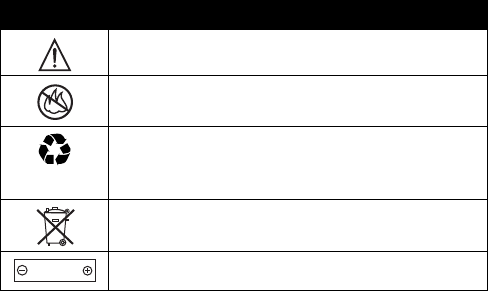
DRAFT
13
Your battery, charger, or phone may contain symbols, defined as follows:
Choking Hazards
Your phone or its accessories may include detachable parts, which may
present a choking hazard to small children. Keep your phone and its
accessories away from small children.
Seizures/Blackouts
Some people may be susceptible to epileptic seizures or blackouts when
exposed to flashing lights, such as when watching television or playing
video games. These seizures or blackouts may occur even if a person
never had a previous seizure or blackout.
If you have experienced seizures or blackouts, or if you have a family
history of such occurrences, please consult with your doctor before
playing video games on your phone or enabling a flashing-lights feature
on your phone. (The flashing-light feature is not available on all products.)
Parents should monitor their children’s use of video game or other
features that incorporate flashing lights on the phones. All persons should
discontinue use and consult a doctor if any of the following symptoms
Symbol Definition
Important safety information will follow.
Your battery or phone should not be disposed of in a
fire.
Your battery or phone may require recycling in
accordance with local laws. Contact your local
regulatory authorities for more information.
Your battery or phone should not be thrown in the
trash.
Your phone contains an internal lithium ion battery.
032374o
032376o
032375o
032377o
032378o
Li Ion BATT
DRAFT
14
occur: convulsion, eye or muscle twitching, loss of awareness, involuntary
movements, or disorientation.
To limit the likelihood of such symptoms, please take the following safety
precautions:
•
Do not play or use a flashing-lights feature if you are tired or need
sleep.
•
Take a minimum of a 15-minute break hourly.
•
Play in a room in which all lights are on.
•
Play at the farthest distance possible from the screen.
Repetitive Motion Injuries
When you repetitively perform actions such as pressing keys or entering
finger-written characters, you may experience occasional discomfort in
your hands, arms, shoulders, neck, or other parts of your body. Follow
these instructions to avoid problems such as tendonitis, carpal tunnel
syndrome, or other musculoskeletal disorders:
•
Take a minimum 15-minute break every hour of game playing.
•
If your hands, wrists, or arms become tired or sore while playing,
stop and rest for several hours before playing again.
•
If you continue to have sore hands, wrists, or arms during or after
play, stop playing and see a doctor.
1. The information provided in this document supersedes the general safety
information in user’s guides published prior to January 28, 2005.
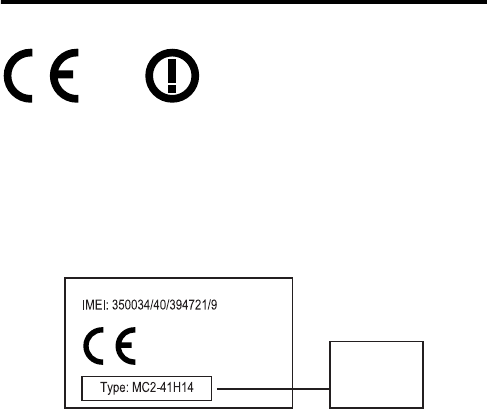
DRAFT
15
European Union Directives
Conformance Statement
Hereby, Motorola declares that this product is in compliance with:
•
The essential requirements and other relevant provisions of
Directive 1999/5/EC
•
All other relevant EU Directives
The above gives an example of a typical Product Approval Number.
You can view your product’s Declaration of Conformity (DoC) to Directive
1999/5/EC (the R&TTE Directive) at
www.motorola.com/rtte
- to
find your DoC, enter the product Approval Number from your product’s
label in the “Search” bar on the Web site.
[France Only]
0168
Product
Approval
Number

DRAFT
16
Caring for the Environment by
Recycling
When you see this symbol on a Motorola product, do not dispose
the product with household waste.
Recycling Mobile Phones and
Accessories
Do not dispose of mobile phones or electrical accessories, such as
chargers or headsets, with your household waste. In some countries or
regions, collection systems are set up to handle electrical and electronic
waste items. Contact your regional authorities for more details. If
collection systems aren’t available, return unwanted mobile phones or
electrical accessories to any Motorola Approved Service Centre in your
region.
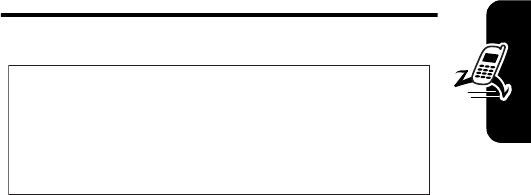
DRAFT
17
Getting Started
Getting Started
About This Guide
This guide describes the basic features of your phone.
Selecting a Menu Feature
Use the menu system to access your phone’s features.
This guide shows you how to select a menu feature from
the home screen as follows:
This example shows that, from the home screen, you must
press the menu key
M
to open the menu, scroll to and
select
s
Recent Calls
, then scroll to and select
Dialed Calls
.
Press the 5-way navigation key
S
to scroll and highlight a
menu feature. Press
SELECT
(
+
) to select the highlighted
menu feature.
Find the Feature
M
>
Recent Calls
>
Dialed Calls
CAUTION: Before using the phone for the
first time, read the
Important Safety and
Legal Information
included in the
gray-edged pages at the back of this guide.
032259o
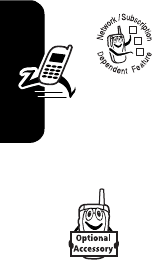
DRAFT
18
Getting Started
Optional Features
This label identifies an optional network, SIM
card, or subscription-dependent feature that
may not be offered by all service providers in
all geographical areas. Contact your service
provider for more information.
Optional Accessories
This label identifies a feature that requires an
optional Motorola Original™ accessory.
Installing the SIM Card
Yo u r Subscriber Identity Module (SIM) card contains your
phone number, service details, and phonebook/message
memory.
032380o
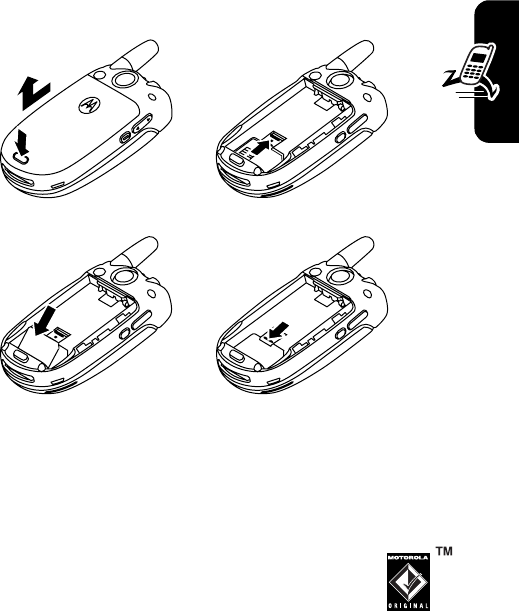
DRAFT
19
Getting Started
Caution:
Do not bend or scratch your SIM card. Avoid
exposing your SIM card to static electricity, water, or dirt.
Battery Tips
Battery life depends on the network, signal strength,
temperature, features, and accessories you use.
•
Always use Motorola Original batteries and
chargers. The warranty does not cover
damage caused by using non-Motorola
batteries and/or chargers.
•
New batteries or batteries stored for a long time may
take more time to charge.
1. 2.
3. 4.

DRAFT
20
Getting Started
•
When charging your battery, keep it near room
temperature.
•
When storing your battery, keep it uncharged in a
cool, dark, dry place, such as a refrigerator.
•
Never expose batteries to temperatures below
-10°C (14°F) or above 45°C (113°F). Always take
your phone with you when you leave your vehicle.
•
It is normal for batteries to gradually wear down and
require longer charging times. If you notice a change
in your battery life, it is probably time to purchase a
new battery.
Contact your local recycling center for proper
battery disposal.
Warning:
Never dispose of batteries in a fire because they
may explode.
Before using your phone, read the battery safety
information in the “Safety and General Information” section
included in the gray-edged pages at the back of this guide.
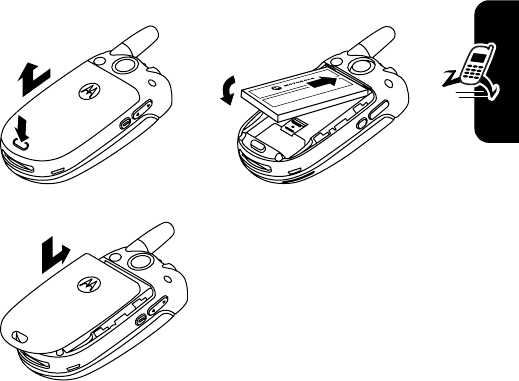
DRAFT
21
Getting Started
Installing the Battery
1. 2.
3.
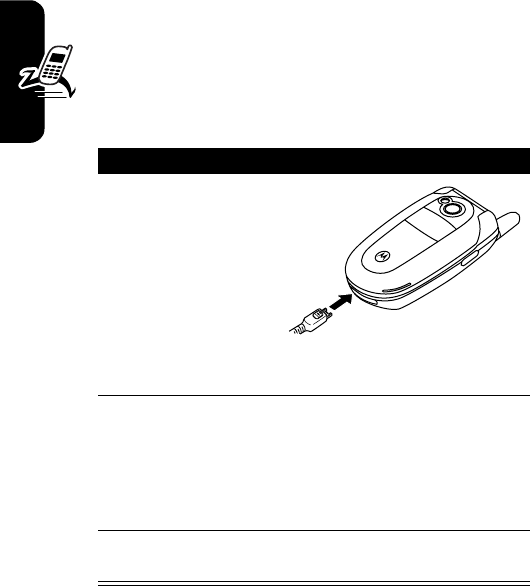
DRAFT
22
Getting Started
Charging the Battery
New batteries are shipped partially charged. Before
you can use your phone, you need to install and charge
the battery, as indicated by the following instructions.
Some batteries perform best after several full
charge/discharge cycles.
Tip:
You can safely leave the travel charger connected to
the phone after charging is complete. This will
not
damage
the battery.
Action
1
Insert the travel
charger plug
into your phone
with the release
tab facing up.
Make sure that
both of the
plug’s connector
hooks engage to lock the plug in place.
2
Plug the other end of the travel charger into the
appropriate electrical outlet.
Note:
It make take up to 10 seconds for your
phone to provide a visible or audible indication
that the battery is charging.
3
When your phone indicates
Charge Complete
, press
the release tab and remove the travel charger.
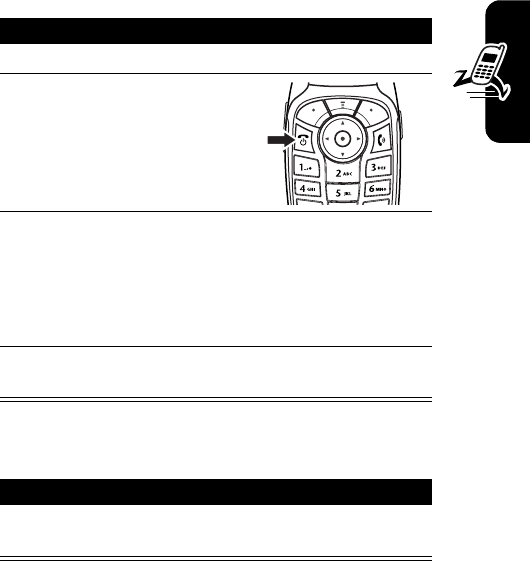
DRAFT
23
Getting Started
Turning Your Phone On
Turning Your Phone Off
Action
1
Open your phone.
2
Press and hold the
power key
P
for a few
seconds or until the
display turns on.
3
If necessary, enter your SIM card PIN code and
press
OK
(
+
) to unlock the SIM card.
Caution:
If you enter an incorrect PIN code 3
times in a row, your SIM card is disabled and
your phone displays
SIM Blocked
.
4
If necessary, enter your 4-digit unlock code and
press
OK
(
+
) to unlock the phone.
Action
Press and hold the power key
P
for 2 seconds to
turn the phone off.
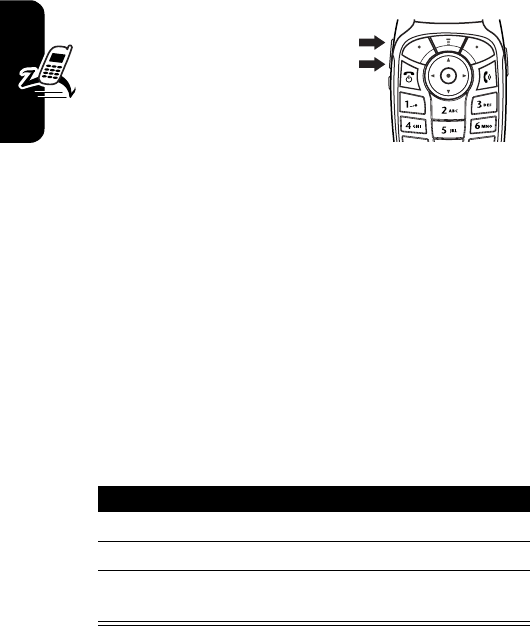
DRAFT
24
Getting Started
Adjusting Volume
Press the up or down volume
keys to:
•
silence an incoming call
alert
•
increase or decrease
earpiece volume during a
call
•
increase or decrease ringer volume when the home
screen is visible (flip must be open)
Tip:
At the lowest volume setting, press the down
volume key once to switch to vibrate alert. Press it
again to switch to silent alert. Press the up volume key
to switch back to vibrate alert, then ring alert.
Making a Call
You must be in the home screen to dial a phone number
(see page 45).
Tip:
You can also close the phone flip to end the call.
Press To
1
keypad keys dial the phone number
2
N
make the call
3
O
end the call and “hang up” the
phone when you are finished
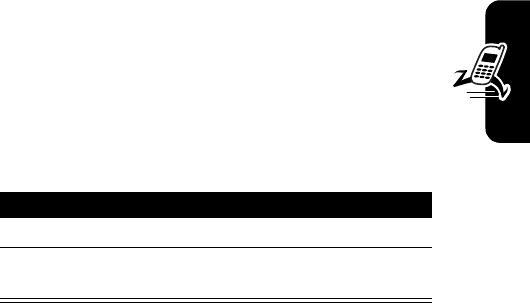
DRAFT
25
Getting Started
Answering a Call
When you receive a call, your phone rings and/or
vibrates and displays an incoming call message.
When the phone flip is active, open the phone to
answer the call. (To activate, press
M
>
Settings
>
In-Call Setup
>
Answer Options
>
Open to Answer
.)
If the phone flip is
not
active:
Viewing Your Phone Number
To view your phone number from the home screen, press
M#
.
While you are on a call, press
M
>
My Tel. Numbers
.
Note:
Your phone number must be stored on your SIM
card to use this feature. To store your phone number on
the SIM card, see page 80. If you do not know your phone
number, contact your service provider.
Press To
1
N
or
ANSWER
(
+
) answer the call
2
O
end the call and “hang up” the
phone when you are finished
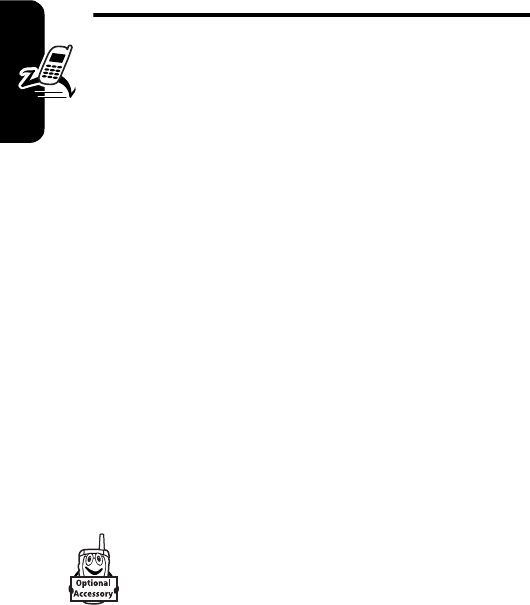
DRAFT
26
Highlight Features
Highlight Features
You can do much more with your phone than make and
receive calls!
Using a Personal Area Network
You can make and receive calls with your phone using a
personal area network connection instead of a cellular
GSM network connection. To use a personal area network,
you must use Bluetooth wireless pairing (also called linking
or bonding) to pair your phone with an access point.
Note:
Contact your service provider for additional
information about using this feature.
Note: Your phone's Bluetooth features and Bluetooth
Class 1 power levels are not allowed for outdoor
operation in France. To avoid unlawful interference
with radio signals, do not use the Bluetooth features
in France unless you are indoors
.
Pairing With an Access Point
Before you try to pair your phone with an
access point
, make sure the access point device
is
on
and
ready
to connect in pairing or bonding

DRAFT
27
Highlight Features
mode (see the user’s guide for the access point). You can
pair your phone with only one access point at a time.
Your phone lists the access points within range of the
phone.
1
Highlight an access point in the list and press
SELECT
(
+
).
2
Press
YES
(
-
) to pair with the access point.
3
Enter the access point passkey and press
OK
(
+
).
When your phone is paired, the Bluetooth indicator
à
displays in the home screen. After pairing with the access
point, the personal area network indicator
ò
displays
when you are connected to the personal area network. For
more information about the personal area network
indicator, see page 47.
Tip:
For specific information about an access point device,
see the instructions that came with it.
Pairing With Recognized Access Points
Your phone stores the names of previously paired
access points, and lists the recognized access
points located within range of the phone when you
open the
Access Points
menu. If your phone is
already paired with an access point, the phone identifies it
with an in-use indicator
o
.
Find the Feature
M
>
Settings
>
Connection
>
Bluetooth Link
>
Access Points
>
[Look For Devices]
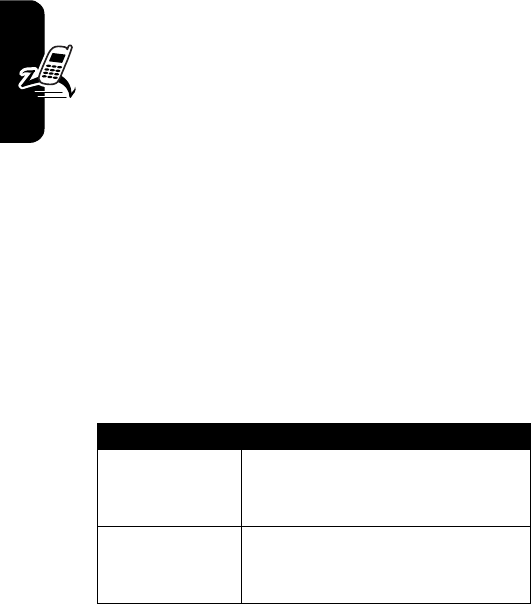
DRAFT
28
Highlight Features
To pair with a recognized access point:
Setting Access Point Priority
You can specify the conditions under which your phone
uses a personal area network connection or a GSM
network connection to make and receive calls.
Shortcut:
From the home screen, press
ACCESS PT.
(
+
) to
set access point priority.
To set the access point priority from the menu:
Select one of the following access point priority options:
Find the Feature
M
>
Settings
>
Connection
>
Bluetooth Link
>
Access Points
>access point name
Find the Feature
M
>
Settings
>
Access Point Priority
Option Description
Access Point
Preferred
Your phone automatically
connects with an access point
when available (default setting).
GSM Preferred
Connect with an available access
point
only
when a GSM network
connection is not available.
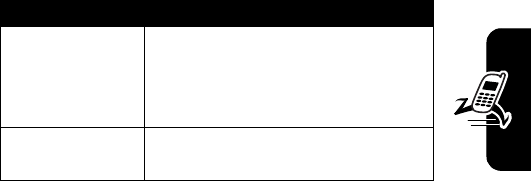
DRAFT
29
Highlight Features
Note:
If Bluetooth power is turned off, your phone
automatically turns Bluetooth power on when you set
access point priority to
Access Point Preferred
,
GSM Preferred
, or
Access Point Only
. To turn Bluetooth power off, you must set
access point priority to
GSM Only
.
Recording and Playing Video
Clips
You can record a video clip with your phone, and send it to
other wireless phone users in a multimedia message.
Recording a Video Clip
To activate your phone’s video camera:
Access Point Only
Automatically connect with an
access point when available. Do
not
use a GSM network
connection.
GSM Only
Do
not
connect with an available
access point.
Find the Feature
M
>
Multimedia
>
Videos
>
[New Video]
Option Description
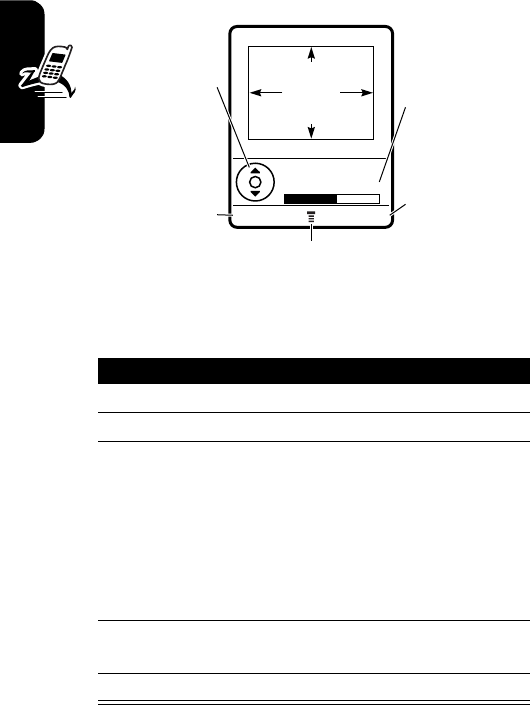
DRAFT
30
Highlight Features
The active viewfinder image appears on your display.
Point the camera lens at the video subject, then:
Press To
1
CAPTURE
(
+
) begin video recording
2
STOP
(
+
) stop video recording
3
STORE
(
+
)
or
DISCARD
(
-
)
view storage options
If you choose to store the
video, continue to step 4.
delete the video and return to
active viewfinder
4
S
scroll to
Send in Message
or
Store Only
5
SELECT
(
+
) perform the storage option
BACK CAPTURE
Press
S
up or
down to zoom
in or out.
Press
BACK
(
-
) to
exit the video
camera
application.
Press
M
to open
Videos Menu
.
Video Storage
Space Used
Press
CAPTURE
(
+
) to
record a video.
Video Viewfinder
Memory Used:55%
VIDEO
CLIP
AREA
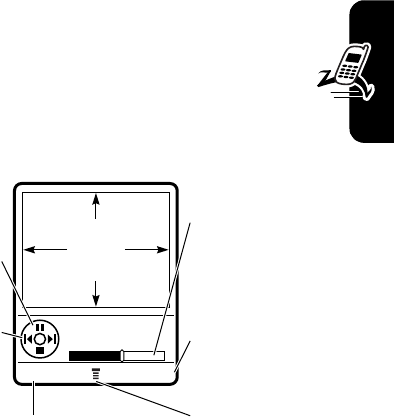
DRAFT
31
Highlight Features
Playing a Video Clip
To play a video clip stored on your phone:
The video clip displays in the video clip playback
screen.
Find the Feature
M
>
Multimedia
>
Videos
>video clip
VIDEO
CLIP
AREA
BACK DETAILS
Press
S
up or
down to pause
or play video
clip.
Press
S
left
or right to skip
to previous or
next video clip.
Press
BACK
(
-
)
to exit the video
player.
Press
M
to
open
Videos
Menu
.
Timer indicates
% played.
Press
DETAILS
(
+
) to
view video clip
information.
Video Clip Name
Playing
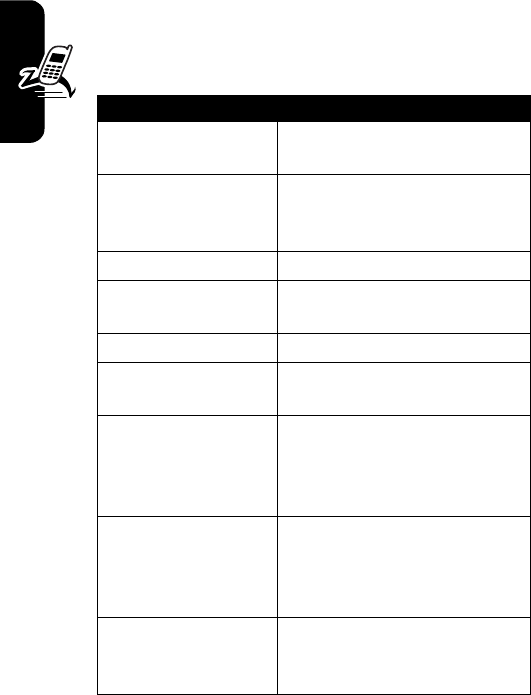
DRAFT
32
Highlight Features
Adjusting Video Settings
Press
M
to open the
Videos Menu
during video recording or
playback. The
Videos Menu
can include the following
options:
Option Description
Go To Videos
View video clips stored on
your phone.
Send In Message
Insert selected video clip or
marked video clips in a new
message.
Details
View video clip information.
New
Activate the videocamera to
record a new video clip.
Rename
Rename the video clip.
Delete
Delete the selected video clip
or all marked video clips.
Move
Move selected video clip or
marked video clips to another
device, and delete original
video(s) from phone memory.
Copy
Copy selected video clip or
marked video clips to another
device, and leave copy of
video(s) on phone.
Mark/Unmark
or
Mark All/Unmark All
Mark one or more video clips
that you want to move, copy,
send, or delete.
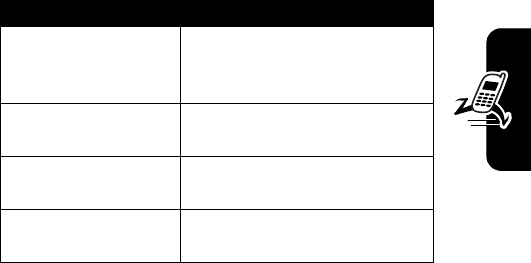
DRAFT
33
Highlight Features
Categories
Create a new category, or
view video clips in a selected
category.
Assign To Category
Assign the video clip to a
defined category.
Videos Setup
Open the setup menu to
adjust video settings.
View Free Space
View memory space available
for storing video clips.
Option Description
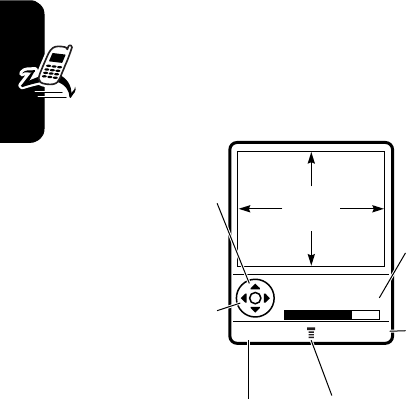
DRAFT
34
Highlight Features
Taking and Sending a Photo
To activate your phone’s camera:
The active viewfinder image appears on your display.
Find the Feature
M
>
Multimedia
>
Camera
IMAGE
AREA
BACK CAPTURE
Press
BACK
(
-
) to exit the
camera application.
Press
S
up or
down to zoom
in or out.
Press
S
left
or right to
decrease or
increase image
brightness.
Press
M
to open
Pictures Menu
.
Photo Storage
Space Used
Press
CAPTURE
(
+
) to
take a photo.
Photo Viewfinder
Memory Used:72%
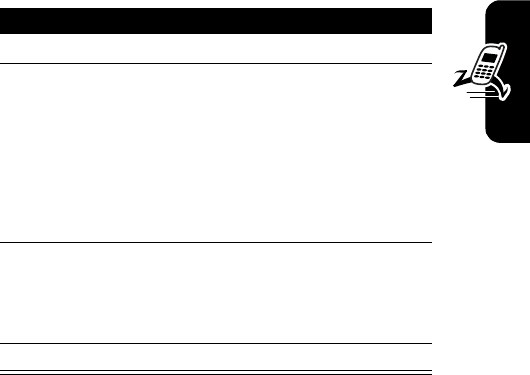
DRAFT
35
Highlight Features
Point the camera lens at the photo subject, then:
Taking a Self-Portrait
Activate the camera and then press
M
>
Auto-Timed Capture
. Press
S
left or right to set a 5 or
10 second timer delay, then press
START
(
+
). Close the
flip, and use the mirror to aim the camera lens. When you
hear the camera click, open the flip to see your photo.
Press To
1
CAPTURE
(
+
) take a photo
2
STORE
(
+
)
or
DISCARD
(
-
)
view storage options
If you choose to store the
photo, continue to step 3.
delete the photo and return to
active viewfinder
3
S
scroll to
Send in Message
,
Store Only
,
Apply as Wallpaper
,
Apply as Screen Saver
, or
Apply as Phonebook Entry
4
SELECT
(
+
) perform the storage option
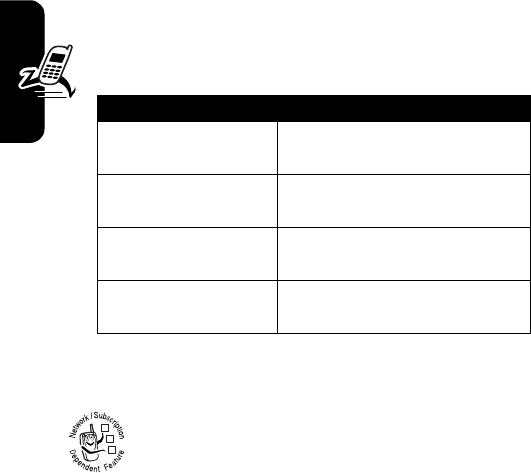
DRAFT
36
Highlight Features
Adjusting Camera Settings
Press
M
to open the
Pictures Menu
when the camera is
active. The
Pictures Menu
can include the following
options:
Sending a Multimedia Message
A Multimedia Messaging Service (MMS)
multimedia message contains one or more pages
with text and embedded media objects (including
photos, pictures, animations, sounds, voice
records, and video clips). You can send a multimedia
message to other wireless phone users, and to email
addresses.
Tip:
The layout of all pages in a multimedia message is
defined by the layout of the first page. To display a media
object at the top of the page, insert it in the first half of the
Option Description
Go To Pictures
View pictures and photos
stored on your phone.
Auto-Timed Capture
Set a timer for the camera to
take a photo.
Pictures Setup
Open the setup menu to
adjust picture settings.
View Free Space
See how much memory
remains for storing pictures.
032380o
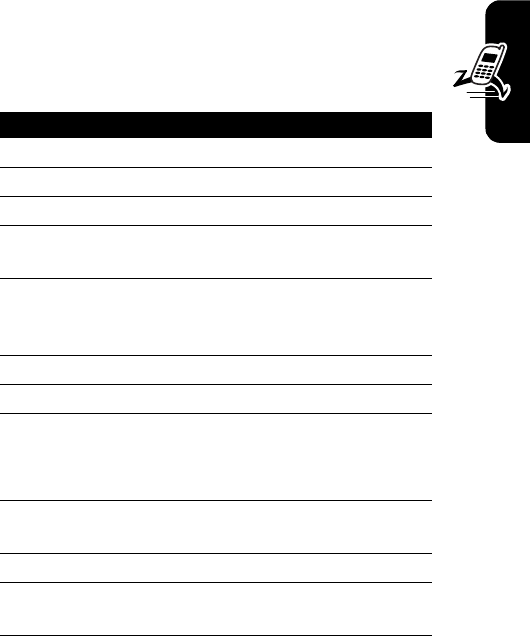
DRAFT
37
Highlight Features
message text. To display a media object at the bottom of
the page, insert it in the second half of the message text.
Find the Feature
M
>
Messages
>
Create Message
>
New Multimedia Msg
Press To
1
keypad keys enter text on the page
2
M
open the
MMS Menu
3
S
scroll to
Insert
4
SELECT
(
+
) display a list of items you can
insert
5
S
scroll to
Picture
,
Voice Record
,
Sound
,
Video
,
New Page
,
Quick Note
,
or
Contact Info
6
SELECT
(
+
) select the file type
7
S
highlight the file you want
8
SELECT
(
+
) insert the file
To add another page to the
message, continue to step 9.
9
M
open the
MMS Menu
to insert a
new page
10
S
scroll to
Insert
11
SELECT
(
+
) display a list of items you can
insert
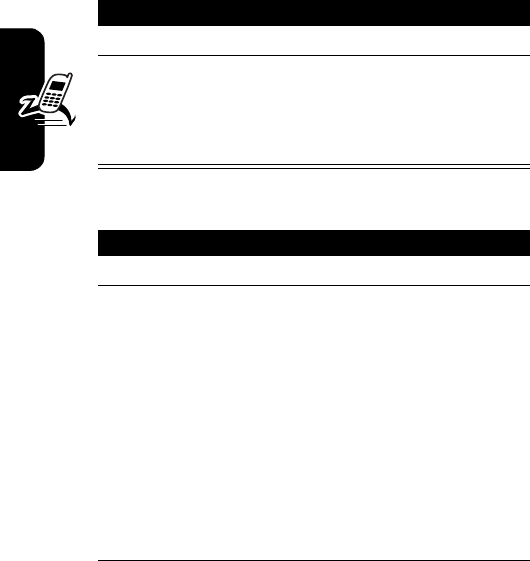
DRAFT
38
Highlight Features
When you finish composing the multimedia message:
12
S
scroll to
New Page
13
SELECT
(
+
) insert a new page after the
current page
Repeat steps 1 to 8 to enter
contents for the new page.
Press To
1
OK
(
+
) store the message
2
S
scroll to a
Send To
option:
Highlight an existing
phonebook entry.
Or highlight
[One Time Entry]
to
enter one or more phone
numbers or email addresses.
Or highlight
[New Phonebook Entry]
to enter a
number/address and add it to
the phonebook.
Press To
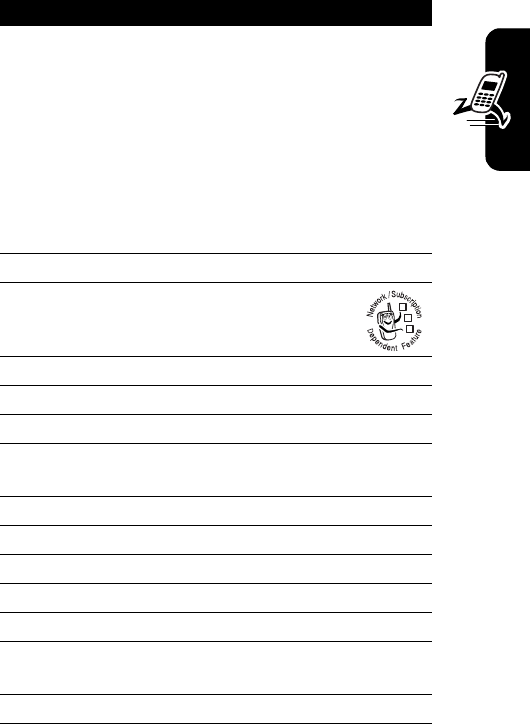
DRAFT
39
Highlight Features
3
ADD
(
+
)
or
SELECT
(
+
)
add a phonebook entry to the
list of recipients
Repeat steps 2 and 3 to add
additional phonebook entries
to the list.
select
[One Time Entry]
or
[New Phonebook Entry]
4
DONE
(
+
) store the numbers/addresses
5
S
scroll to
Subject
6
CHANGE
(
-
)select
Subject
7
keypad keys enter the subject
8
OK
(
+
) store the subject
9
CHANGE
(
-
)select
Attachments
to attach a
file to the message, if desired
10
S
scroll to
Picture
,
Sounds
, or
Video
11
SELECT
(
+
) select the file type
12
S
highlight the file you want
13
SELECT
(
+
) attach the file
14
BACK
(
-
) return to the message editor
15
S
scroll to
Receipt
to request a
receipt, if desired
16
CHANGE
(
-
)select
Receipt
Press To
032380o
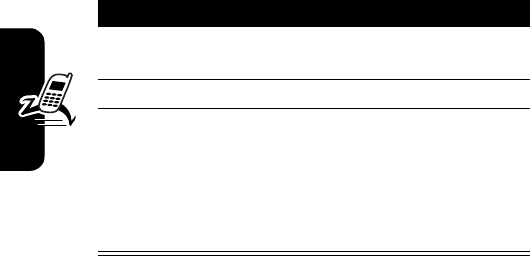
DRAFT
40
Highlight Features
Using Bluetooth
®
Wireless
Pairing
Your phone supports Bluetooth wireless pairing (also
called linking or bonding). You can pair your phone with a
Bluetooth headset or car kit, or pair your phone with
another Bluetooth phone or a computer to exchange and
synchronize files.
Note:
The use of wireless devices and their accessories
may be prohibited or restricted in certain areas. Always
obey the laws and regulations on the use of these
products.
Note: Your phone's Bluetooth features and Bluetooth
Class 1 power levels are not allowed for outdoor
operation in France. To avoid unlawful interference
with radio signals, do not use the Bluetooth features
in France unless you are indoors
.
17
ADD
(
+
) or
REMOVE
(
+
)
activate/deactivate the
delivery report
18
DONE
(
-
) return to the message editor
19
SEND
(
+
)
or
M
send the message
view message details, save
the message in the drafts
folder, or cancel the message
Press To

DRAFT
41
Highlight Features
Turning Bluetooth Power On or Off
To turn Bluetooth power on:
When Bluetooth power is on, your phone can automatically
pair with the handsfree device you have used before, when
you turn on the device and move it within range of the
phone.
Note:
To extend battery life, use the above procedure and
set Bluetooth power to
Off
when not in use. Your phone will
not pair with devices until you set Bluetooth power back to
On
and pair your phone with the devices again.
Pairing With a Headset or Handsfree Device
Before you try to pair your phone with a
device
, make sure your phone’s Bluetooth power
is
on
and the device is
on
and
ready
in pairing or
bonding mode (see the user’s guide for the
device). You can pair your phone with only one device at a
time.
If Bluetooth power is turned off, your phone asks if you
want to
Temporarily Power On?
the Bluetooth power setting.
Press
YES
(
-
) to proceed. Alternatively, set
Power
to
On
in
the
Setup
menu to turn Bluetooth power on and leave it on.
Find the Feature
M
>
Settings
>
Connection
>
Bluetooth Link
>
Setup
>
Power
>
On
Find the Feature
M
>
Settings
>
Connection
>
Bluetooth Link
>
Handsfree
>
[Look For Devices]

DRAFT
42
Highlight Features
Your phone lists the devices within range of the phone.
1
Highlight a device in the list and press
SELECT
(
+
).
2
Press
YES
(
-
) to pair with the device.
3
If necessary, enter the device passkey (such as
0000
) and press
OK
(
+
).
When your phone is paired, the Bluetooth indicator
à
displays in the home screen.
Tip:
For specific information about a device, see the
instructions that came with it.
Copying Objects to Another Device
You can use Bluetooth pairing to copy a media
object, phonebook entry, datebook event, or
bookmark from your phone to a computer or other
device.
Sending a Picture, Sound, or Video
Highlight the media object on your phone that you want to
send to the other device, then press
M
>
Copy.
Select a recognized device name listed in the
Object Exchange
menu, or
[Look For Devices]
to search for the device to which
you want to send the object.
Sending a Phonebook Entry, Datebook Event, or
Bookmark
Highlight the item on your phone that you want to send to
the other device, then press
M
>
Send.
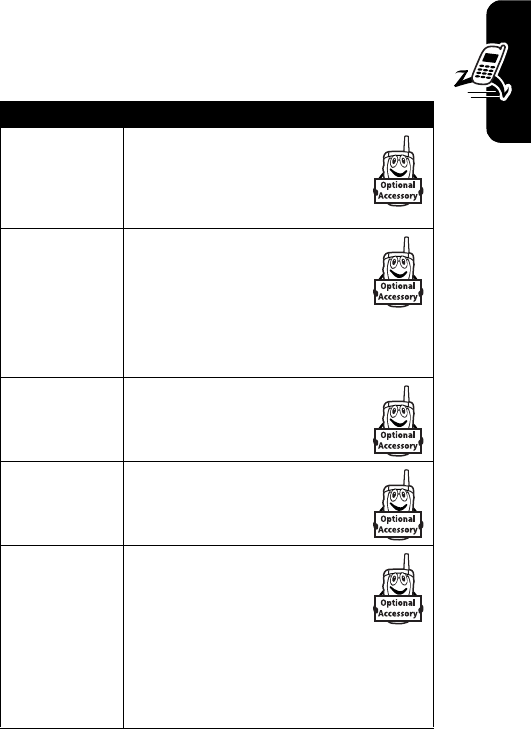
DRAFT
43
Highlight Features
Select a recognized device name listed in the
Object Exchange
menu, or
[Look For Devices]
to search for the device to which
you want to send the item.
Advanced Bluetooth
®
Features
Feature Description
Make Phone
Visible to
Other
Device
Allow a Bluetooth device to
discover your phone:
M
>
Settings
>
Connection
>
Bluetooth Link
>
Setup
>
Find Me
Pair With
Recognized
Device
Pair your phone with a
recognized handsfree
device:
M
>
Settings
>
Connection
>
Bluetooth Link
>
Handsfree
>device name
Drop
Pairing With
Device
Highlight the device name
and press
DROP
(
+
).
Switch to
Device
During Call
Switch to a headset or car
kit during a call:
M
>
Use Bluetooth
Move
Multimedia
Object to
Device
Move a multimedia object to
another device:
Highlight the object, press
M
>
Move
, select the
device name.
Caution:
Moving an object
deletes
the original object from your phone.
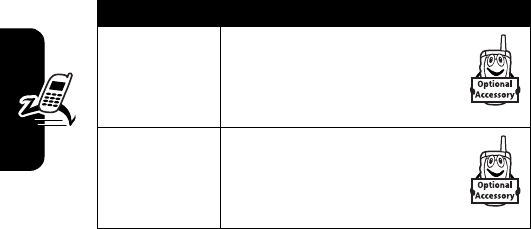
DRAFT
44
Highlight Features
Edit Device
Properties
Edit the properties of a
recognized device:
Highlight the device name
and press
M
>
Edit
.
Set
Bluetooth
Options
Set your phone’s Bluetooth
options:
M
>
Settings
>
Connection
>
Bluetooth Link
>
Setup
Feature Description
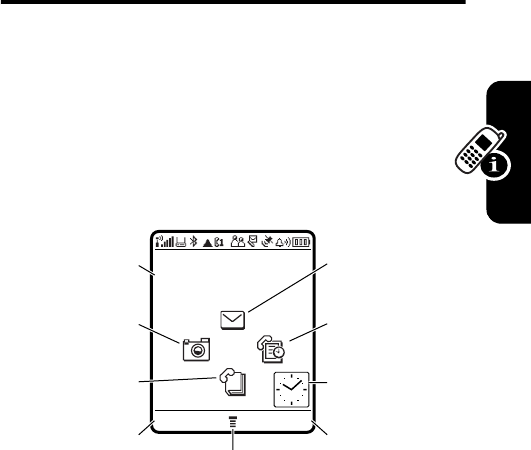
DRAFT
45
Learning to Use Your Phone
Learning to Use Your
Phone
See page 1 for a basic phone diagram.
Using the Display
The home screen is displayed when you are
not
on a
call or using the menu. You must be in the home screen
to dial a phone number.
Press the 5-way navigation key
S
up, down, left, or right
to select a menu feature icon. If you select a menu feature
by mistake, press
O
to return to the home screen.
The menu indicator
M
shows that you can press the menu
key
M
to enter the main menu.
Menu Indicator
Service Provider
10/15/05
STYLES ACCESS PT.
Left Soft Key
Label
Right Soft Key
Label
Date
Camera
Messages
Clock
Recent Calls
Phonebook

DRAFT
46
Learning to Use Your Phone
Labels at the bottom corners of the display show the
current soft key functions. Press the left soft key
-
or
right soft key
+
to perform the indicated function.
Notes:
•
Your home screen may appear different than shown.
For example, the menu feature icons normally are
hidden to allow a better view of the wallpaper image.
You can still select the menu icons when they are
hidden from view. To show or hide menu icons,
see page 99.
•
Your phone can display an analog or digital clock
in the home screen (see page 99).
•
Your phone’s display normally is visible only when the
display backlight is on, or when the display is viewed
in direct sunlight. To extend battery life, the backlight
turns off automatically when no activity is detected for
a specified time. The backlight turns back on when
you open the flip or press any key. To set the time that
the backlight stays on, see page 79.
•
To further extend battery life, you can set the display
to turn off (in addition to the backlight) when no
activity is detected for a specified time. The display
turns back on when you open the flip or press any key.
To set the time that the display stays on, see page 80.
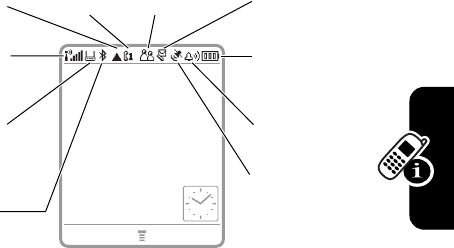
DRAFT
47
Learning to Use Your Phone
The following status indicators can display:
1. Data Indicator –
Shows data transmission status. The
Bluetooth
®
indicator
à
shows when your phone is paired
with another device. Other indicators can include:
4
= secure packet
data transfer
7
= unsecure packet
data transfer
3
= secure
application
connection
6
= unsecure
application
connection
2
= secure Circuit
Switch Data
(CSD) call
5
= unsecure CSD
call
Service Provider
10/15/05
STYLES ACCESS PT.
3.
Signal
Strength
8.
Battery
Level
2.
Home
Coverage
9.
Ring Style
1.
Data
6.
Messaging
Presence
7.
Message
4.
Roam
10.
Location
5.
Active
Line

DRAFT
48
Learning to Use Your Phone
2. Home Coverage Indicator –
The personal
area network indicator
ò
flashes when your
phone attempts to establish a personal area
network connection, and becomes solid when the
connection is made. Other indicators can include:
3. Signal Strength Indicator –
Vertical bars show the
strength of the network connection. You cannot make
or receive calls when the no signal indicator
!
or not
transmit indicator
)
is displayed.
4. Roam Indicator –
The roam indicator
ã
shows when your phone is seeking or using
another network outside your home network.
Other indicators can include:
5. Active Line Indicator –
Shows
?
to indicate
an active call, or
>
to indicate that call forwarding
is on. Indicators for dual-line-enabled SIM cards
can include:
+
=General Packet Radio Service (GPRS)
data connection
*
= GPRS PDP
context active
,
= GPRS packet
data available
8
=2.5G home
9
=2.5G roam
:
= 2G home
;
= 2G roam
@
= line 1 active
B
= line 2 active
A
= line 1 active,
call forward on
C
= line 2 active, call
forward on
032380o
032380o
032380o
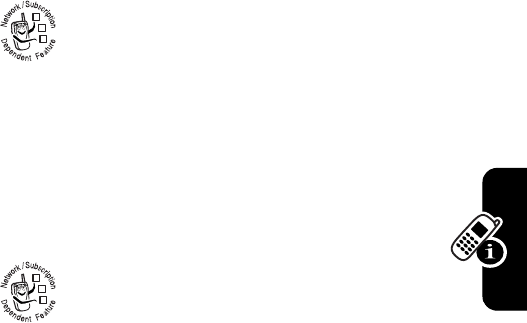
DRAFT
49
Learning to Use Your Phone
6. Messaging Presence Indicator –
Shows
when instant messaging is active. Indicators can
include:
When a Java™ application is active, the Java midlet
indicator
`
displays in this location.
7. Message Indicator –
Displays when you
receive a new message. Indicators can include:
8. Battery Level Indicator –
Vertical bars show the
battery charge level. Recharge the battery when
Low Battery
displays and the battery alert sounds.
9. Ring Style Indicator –
Shows the ring style setting.
P
=IM active
I
= available for IM
_
=busy
Q
= invisible to IM
J
= available for
phone calls
X
= offline
r
=text message
t
=voicemail
message
s
= voicemail and
text message
d
= IM message
a
= active chat
session
y
= loud ring
z
= soft ring
|
=vibrate
†
= vibrate and ring
}
= vibrate then
ring
{
= silent
032380o
032380o
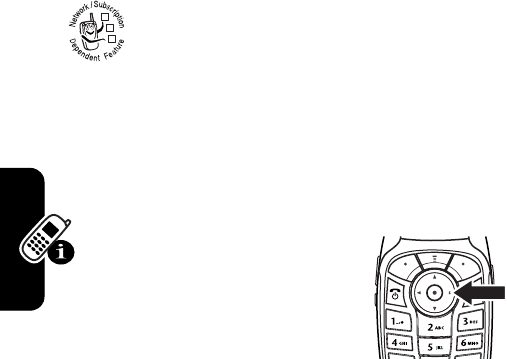
DRAFT
50
Learning to Use Your Phone
10. Location Indicator –
Your phone may be
able to send location information to the network
during an emergency call. Indicators show when
your phone is sending location information:
Using the 5-Way Navigation
Key
Press the 5-way navigation
key
S
up, down, left, or right
to scroll through the menu system,
highlight menu items, change
feature settings, and play games.
Press the center select key
C
in
the center of the 5-way navigation key to select a
highlighted menu item. The center select key usually
performs the same function as the right soft key
+
.
Ö
= location on
Ñ
= location off
032380o
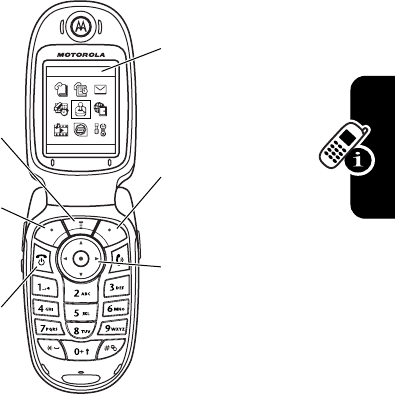
DRAFT
51
Learning to Use Your Phone
Using Menus
From the home screen, press
M
to enter the main menu.
Press
S
to scroll to and highlight a menu feature icon in
the main menu. Press
SELECT
(
+
) or
C
to select the
highlighted menu feature.
5-Way Navigation
Key with Center
Select
Scroll up, down,
left, or right.
Press
C
to select
menu feature.
Highlighted
Menu Feature
Icon
Right Soft Key
Perform right
function.
Left Soft Key
Perform left
function.
Menu Key
Enter menu
system, or open
a sub-menu.
End Key
Exit menu without
making changes.
Games & Apps
EXIT SELECT
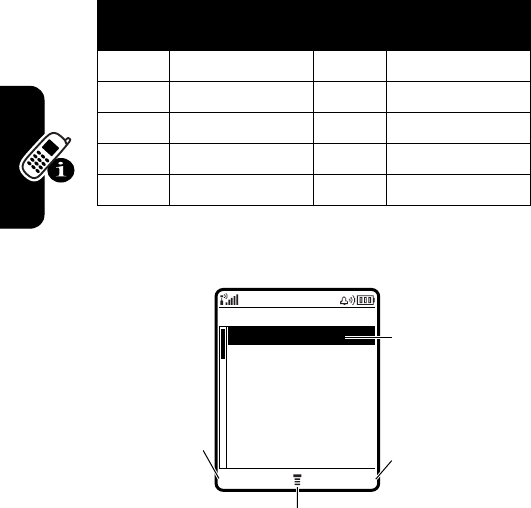
DRAFT
52
Learning to Use Your Phone
The following icons represent features that may display in
the main menu, depending on your service provider and
service subscription options.
Some features require you to select an option from a list:
•
Press
S
to scroll up or down to highlight the option
you want.
•
In a numbered list, press a number key to highlight the
option.
Menu
Icon Feature
Menu
Icon Feature
n
Phonebook
s
Recent Calls
e
Messages
É
Office Tools
Q
Games & Apps
á
Web Access
h
Multimedia
ã
IM
w
Settings
Dialed Calls
BACK VIEW
Press
M
to open sub-menu.
Press
VIEW
(
+
) to
view details of
highlighted
option.
Press
BACK
(
-
) to go
back to
previous
screen.
Highlighted
Option
10) John Smith
9)
Lisa Owens
8)
Adda Thomas
7)
Jack Bradshaw
6)
Dave Thompson
5)
Mary Smith
4)
Carlo Emrys
3)
Bob Adams
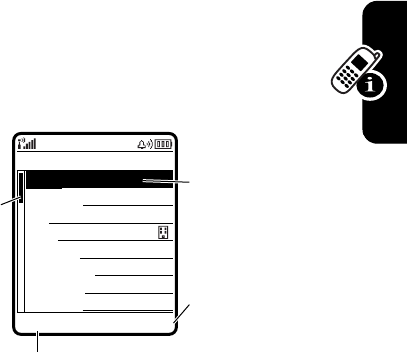
DRAFT
53
Learning to Use Your Phone
•
In an alphabetized list, press a key repeatedly to cycle
through the letters on the key and highlight the closest
matching list option.
•
When an option has a list of possible values, press
S
left or right to scroll through and select a value.
•
When an option has a list of possible numeric values,
press a number key to set the value.
Entering Text
Some features require you to enter information.
Entry Details
CANCEL CHANGE
Press
CANCEL
(
-
) to exit without
making changes.
DONE
(
-
) displays
when you enter or edit information.
Scroll down to
bottom of list to
view more
options. Press
CHANGE
(
+
) to
set or edit
highlighted
option.
Highlighted
option. Press
S
to scroll to
other options.
Name: John Smith
Category: General
No.: 212-555-1212
Type: Work
Store To: Phone
Voice Name:
Speed No.: 2
#
(P)
Ringer ID: Continental
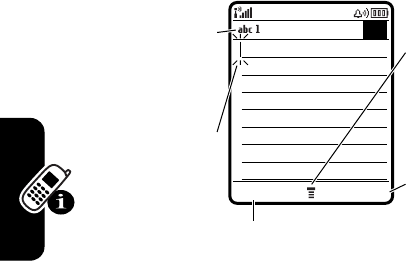
DRAFT
54
Learning to Use Your Phone
Some features let you enter text.
Selecting a Text Entry Mode
Multiple text entry modes make it easy for you to enter
names, numbers, and messages. The mode you select
remains active until you select another mode.
Press
#
in any text entry screen to select one of the
following entry modes:
Alternatively, you can select a text entry mode in any text
entry screen by pressing
M
>
Entry Mode
.
Primary
The primary text entry mode (see
below to set).
Numeric
Enter numbers only (see page 63).
Symbol
Enter symbols only (see page 63).
Secondary
The secondary text entry mode (see
below to set).
Msg 450
CANCEL INSERT
Press
CANCEL
(
-
) to exit without
making changes.
Press
INSERT
(
+
) to
insert a quick
note, picture,
or sound.
For indicator
descriptions,
see following
section.
Flashing cursor
indicates
insertion point.
Press
M
to
open
sub-menu.

DRAFT
55
Learning to Use Your Phone
Setting Primary and Secondary Text Entry Modes
You can set different primary and secondary text entry
modes, and easily switch between modes when you enter
data or compose a message.
Press
M
>
Entry Setup
in a text entry screen. Select
Primary Setup
or
Secondary Setup
, and choose:
Using Capitalization
Press
0
in a text entry screen to change text case.
Indicators at the top of the display show the capitalization
setting:
iTAP
iTAP
®
software predicts each word as
you enter it, to simplify and speed up
text entry.
Tap
Enter letters and numbers by pressing
a key one or more times.
Tap Extended
Enter individual letters, numbers, and
symbols by pressing a key one or
more times.
None
Hide the
Secondary
setting if you prefer
not to set a secondary text entry mode
(only available for
Secondary Setup
).
U
= no capital letters
V
= capitalize next
letter only
T
= all capital letters

DRAFT
56
Learning to Use Your Phone
Text Entry Mode Indicators
In
Primary
or
Secondary
text entry mode, indicators at the top
of the display show the text entry setting:
The following indicators identify
Numeric
or
Symbol
entry
mode:
Using iTAP
®
Mode
iTAP mode lets you enter words using one keypress per
letter. The iTAP software combines your keypresses into
common words, and predicts each word as you enter it.
For example, to enter “
the
,” you would press
843
.
The iTAP software recognizes that the most common word
formed by this keypress combination is “
the
,” and predicts
that “
the
” is the word you are spelling. Other common
words or word fragments that can be spelled by the same
keypress combination are presented as alternate choices
at the bottom of the display.
Primary
Secondary
g
m
Tap, no capital letters
h
q
Tap, capitalize next letter
only
f
l
Tap, all capital letters
j
p
iTAP, no capital letters
k
n
iTAP, capitalize next
letter only
i
o
iTAP, all capital letters
W
= numeric mode
[
= symbol mode
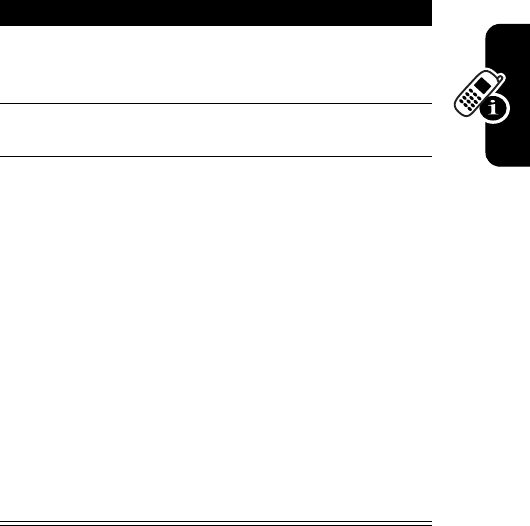
DRAFT
57
Learning to Use Your Phone
If necessary, press
#
in a text entry screen to switch to
iTAP
mode. An indicator tells you which mode is active (see
page 56). If
iTAP
mode is not set as the
Primary
or
Secondary
entry mode, see page 55.
Entering Words i iTAP Mode
Press To
1
Keypad keys
(one press per
letter)
show possible letter
combinations at the bottom of
the display
2
S
left or right highlight the combination you
want
3
S
up
or
*
or
SELECT
(
+
)
accept the predicted word
completion, followed by a
space
enter the highlighted
combination, followed by a
space
select the highlighted
combination, with no space
You can press keypad keys to
add more letters at the end of
the combination.
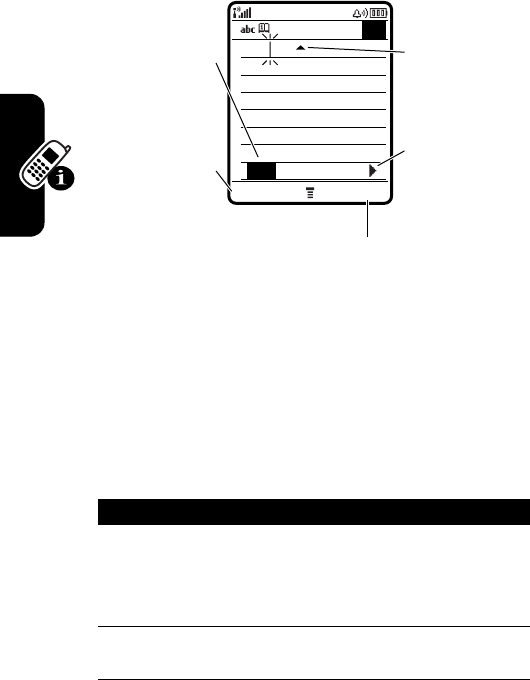
DRAFT
58
Learning to Use Your Phone
For example, if you press
7
7
6
4
, your phone
displays:
If you want a different word (such as
Progress
), continue
pressing keypad keys to enter the remaining characters.
Entering Novel Words in iTAP Mode
You may enter a word that the iTAP software does not
recognize. If your word is not shown as a letter
combination choice at the bottom of the display:
Action
1
Press
DELETE
(
-
) one or more times to delete
letters, until you see a letter combination at the
bottom of the display that matches the start of
the word you want to enter.
2
Press
S
left or right to highlight the letter
combination.
DELETE SELECT
Press
SELECT
(
+
) to select
highlighted combination with no space.
Press
DELETE
(
-
) to
delete last
letter.
Press
*
to
enter
Prog
and
a space.
Press
S
up to
accept
Program
.
Press
S
right
to highlight
another
combination.
Prog ram
Prog Proh Spoi Proi
Msg 442
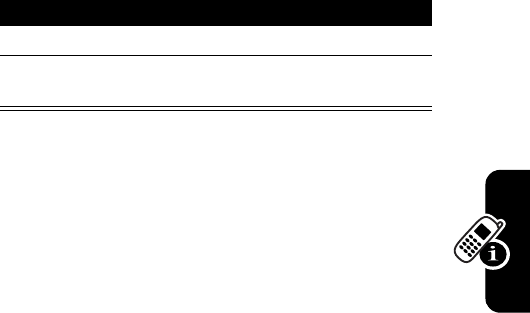
DRAFT
59
Learning to Use Your Phone
Your phone automatically stores the novel word and
displays it as an option the next time you enter its letter
combination. When the memory space for storing novel
words is filled, your phone deletes the oldest words to
add new words.
Entering Numbers and Punctuation in iTAP
Mode
To enter numbers quickly, press and hold a number key to
temporarily switch to numeric mode. Press the number
keys to enter the numbers you want. Enter a space to
revert to
iTAP
mode.
Press
1
to enter punctuation or other characters as
shown in the “Character Chart” on page 62.
Using Tap Mode
This is the basic text entry mode on your phone.
Tap
mode cycles through the letters and number of the key
you press.
Tap Extended
mode also cycles through additional
symbols as shown in the “Character Chart” on page 62.
If necessary, press
#
in a text entry screen to switch to
Tap
mode. An indicator shows which mode is active (see
page 56). If
Tap
or
Tap Extended
is not set as the
Primary
or
Secondary
entry mode, see page 55.
3
Press
SELECT
(
-
) to select the letter combination.
4
Continue to enter letters and select letter
combinations to spell the word.
Action
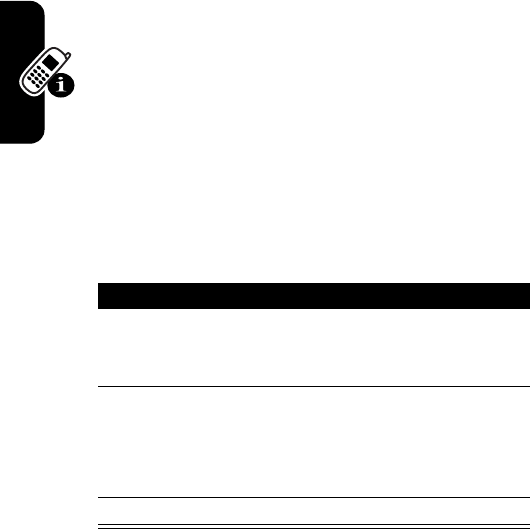
DRAFT
60
Learning to Use Your Phone
Tap Mode Text Entry Rules
•
Press a keypad key repeatedly to cycle through its
characters. For example, you would press
2
one
time to enter “
a
,” two times to enter “
b
,” three times to
enter “
c
,” or four times to enter
“2
.”
•
After 2 seconds,
Tap
mode accepts the character, and
the cursor moves to the next position.
•
The first character of every sentence is capitalized.
If necessary, press
S
down to change the
character to lowercase before the cursor moves to
the next position.
•
Press
S
to move the flashing cursor to enter or edit
message text.
•
If you do not want to save your text or text edits, press
O
to exit without saving.
Entering Words in Tap Mode
Press To
1
a keypad key
one or more
times
select a letter, number, or
symbol
2
keypad keys enter remaining characters
Tip:
Press
S
right to accept
a word completion, or
*
to
insert a space.
3
OK
(
+
) store the text
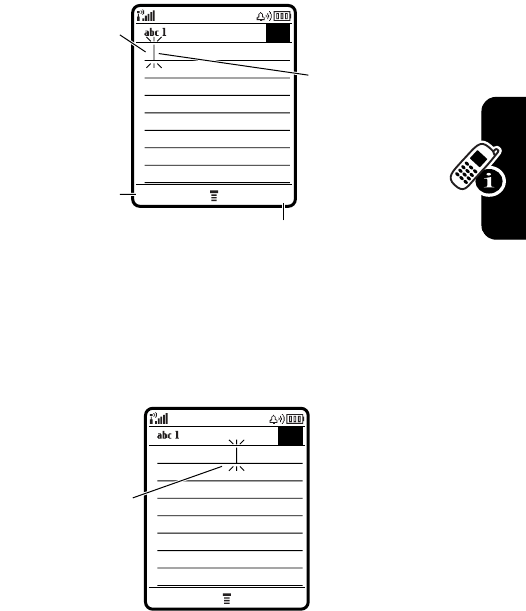
DRAFT
61
Learning to Use Your Phone
For example, if you press
8
one time, your phone
displays:
When you enter 3 or more characters in a row, your phone
may guess the rest of the word. For example, if you enter
“
prog
” your phone might display:
DELETE OK
Press
DELETE
(
-
) to
delete last
character
entered.
Press
OK
(
+
) to accept
and store text.
Character
displays at
insertion point.
After
2 seconds,
character is
accepted and
cursor moves
to next
position.
T
Msg 449
DELETE OK
Press
S
right
to accept
program
. Press
*
to reject it
and enter a
space after
prog
.
To enter a
different word
(such as
progress
), press
keys to enter
remaining
characters.
This is a prog ram
Msg 432
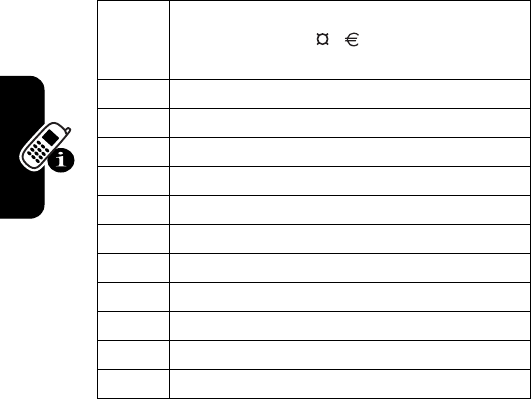
DRAFT
62
Learning to Use Your Phone
Character Chart
Use this chart as a guide for entering characters with
Tap Extended
mode.
Note:
This chart may not reflect the exact character set
available on your phone. In an email or Web address
editor,
1
first shows common characters for that editor.
1
. 1 ? ! , @ _ & ~ : ; " - ( ) '
¿ ¡ % £ $ ¥ + x * / \ [ ]
= > < # §
2
a b c 2 ä å á à â ã
α
β
ç
3
d e f 3
δ
ë é è ê
φ
4
g h i 4 ï í î
γ
5
j k l 5
λ
6
m n o 6 ñ ö ø ó ò ô õ
ω
7
p q r s 7
π
ß
σ
8
t u v 8
θ
ü ú ù û
9
w x y z 9
ξ ψ
0
change text case, for capital letters
*
enter a space (hold to enter a return)
#
change text entry mode (hold for default)
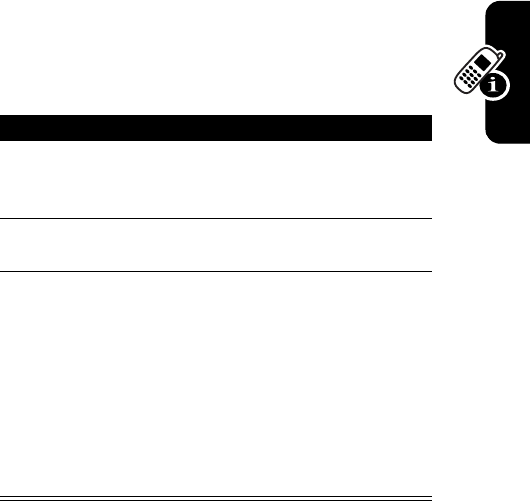
DRAFT
63
Learning to Use Your Phone
Using Numeric Mode
In a text entry screen, press
#
to switch entry modes
until the numeric indicator
W
displays.
Press the number keys to enter the numbers you want.
When you finish entering numbers, press
#
to switch to
another entry mode.
Using Symbol Mode
In a text entry screen, press
#
to switch entry modes
until the symbol indicator
[
displays.
Press To
1
keypad keys
(one press per
symbol)
show possible symbol
combinations at the bottom of
the display
2
S
left or right highlight the combination you
want
3
SELECT
(
+
)
or
*
select the highlighted
combination
You can press keypad keys to
add more symbols to the end
of the combination.
enter the highlighted
combination
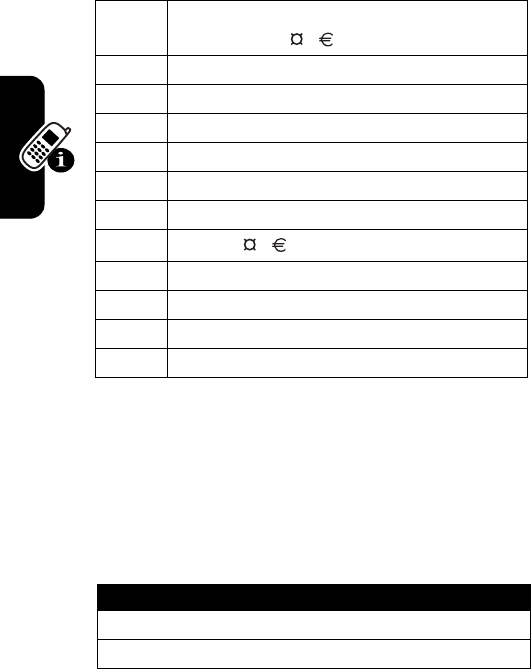
DRAFT
64
Learning to Use Your Phone
Symbol Chart
Use this chart as a guide for entering characters with
symbol mode.
Note:
This chart may not reflect the exact character set
available on your phone. In an email or Web address
editor,
1
first shows common characters for that editor.
Deleting Letters and Words
Place the cursor to the right of the text you want to delete,
and then:
1
. ? ! , @ _ & ~ : ; " - ( ) ' ¿
¡ % £ $ ¥
2
@ _ \
3
/ : ;
4
" & '
5
( ) [ ] { }
6
¿ ¡ ~
7
< > =
8
$ £ ¥
9
# % *
0
+ - x * / = > < # §
*
enter a space (hold to enter a return)
#
change text entry mode (hold for default)
Action
Press
DELETE
(
-
) to delete one letter at a time.
Hold
DELETE
(
-
) to delete the entire message.
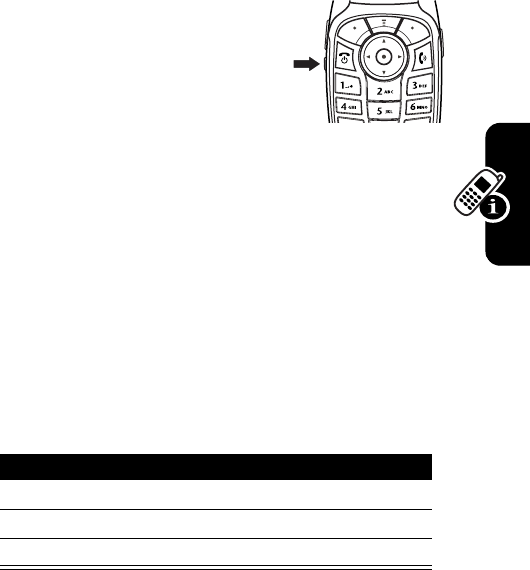
DRAFT
65
Learning to Use Your Phone
Using the Smart Key
The smart key gives you another
way to perform many basic
phone functions. It anticipates
the next action you are likely to
perform. For example, when you
highlight a menu item, you can
press the smart key to select it. You can use the smart
key to make and end calls, turn features on and off, and
open your phonebook. The smart key usually performs
the same function as the right soft key
+
.
Using the External Display
When the flip is closed, the external display shows time
and phone status information. It also displays messages to
notify you of incoming calls and other events. You can
perform the following functions in the external display.
Setting Phone Ring Style
Press To
1
volume keys scroll to
Style
2
smart key select a ring style
3
volume keys return to the home screen
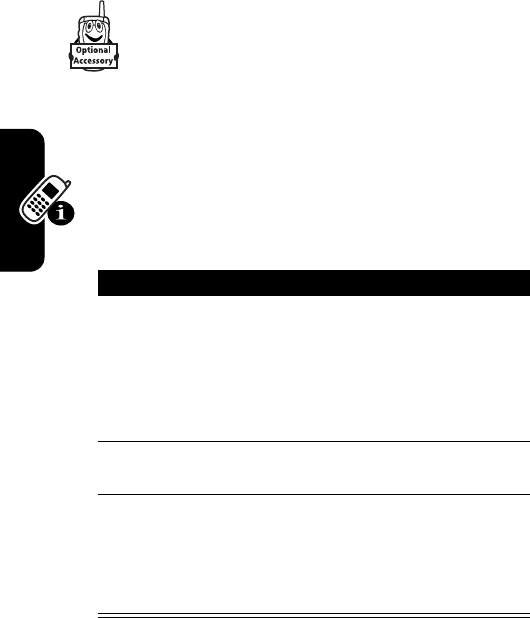
DRAFT
66
Learning to Use Your Phone
Returning an Unanswered Call
Your phone keeps a record of your unanswered
calls and displays
X Missed Calls
in the external
display.
Tip:
Because the microphone and earpiece are
unavailable when the phone is closed, you must use a
headset or other handsfree device with this feature.
Note:
The use of wireless devices and their
accessories may be prohibited or restricted in certain
areas. Always obey the laws and regulations on the
use of these products.
Action
1
Press the smart key to display the received calls
list.
or
Press the volume keys to dismiss the
Missed Calls
message.
2
If necessary, press the volume keys to scroll
through the list and highlight an unanswered call.
3
If a headset is connected to your phone, press
and hold the smart key to call the number.
or
Press the smart key to exit without calling.

DRAFT
67
Learning to Use Your Phone
Using the Handsfree Speaker
When you activate your phone’s integrated handsfree
speaker, you can talk to the other party without holding the
phone to your ear.
Press
SPEAKER
(
+
) to turn the handsfree speaker on or off
during a call.
Your phone displays
Spkrphone On
in the home screen.
The handsfree speaker remains on until you press
SPEAKER
(
+
) again or end the call.
Note:
The handsfree speaker is disabled when you
connect your phone to a handsfree car kit or headset
accessory.
Changing a Code, PIN, or
Password
Your phone’s 4-digit unlock code is originally set to 1234,
and the 6-digit security code is originally set to 000000.
Your service provider may reset these codes before you
receive your phone.
If your service provider has
not
reset these codes, we
recommend that you change them to prevent others from
accessing your personal information. The unlock code
must contain 4 digits, and the security code must contain
6 digits.
You can also reset your SIM card PIN code, PIN2 code,
and/or call barring password if necessary.
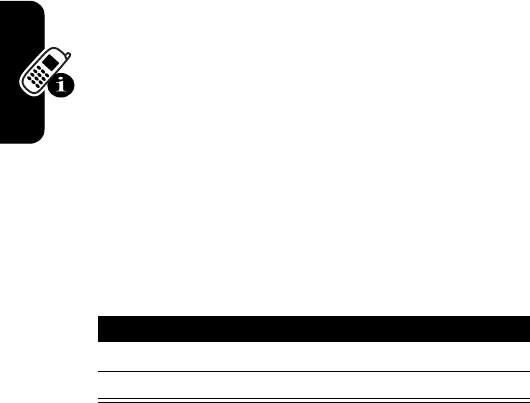
DRAFT
68
Learning to Use Your Phone
To change a code or password:
Locking and Unlocking Your
Phone
You can lock your phone manually or set the phone to
lock automatically whenever you turn it off.
To use a locked phone, you must enter the unlock
code. A locked phone still rings or vibrates for incoming
calls or messages,
but you must unlock it to answer
.
You can make emergency calls on your phone even when
it is locked (see page 87).
Locking Your Phone Manually
Unlocking Your Phone
Tip:
Your phone’s unlock code is originally set to 1234.
Your service provider may reset the unlock code to the last
4 digits of your phone number.
Find the Feature
M
>
Settings
>
Security
>
New Passwords
Find the Feature
M
>
Settings
>
Security
>
Phone Lock
>
Lock Now
Press To
1
keypad keys enter your unlock code
2
OK
(
+
) lock the phone
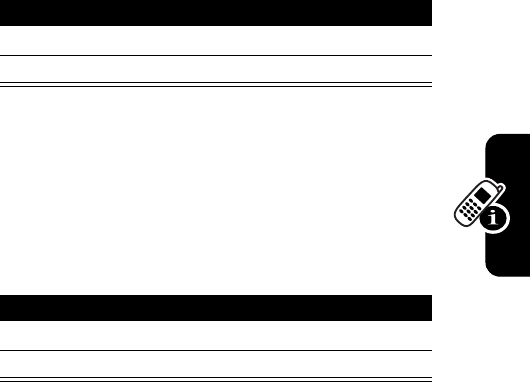
DRAFT
69
Learning to Use Your Phone
At the
Enter Unlock Code
prompt:
Setting Your Phone to Lock Automatically
You can set your phone to lock every time you turn it
off:
If You Forget a Code, PIN, or
Password
Note:
Your phone’s 4-digit unlock code is originally set to
1234, and the 6-digit security code is originally set to
000000. Your service provider may reset the unlock code
to the last 4 digits of your phone number before you
receive your phone.
Press To
1
keypad keys enter your unlock code
2
OK
(
+
) unlock your phone
Find the Feature
M
>
Settings
>
Security
>
Phone Lock
>
Automatic Lock
>
On
Press To
1
keypad keys enter your unlock code
2
OK
(
+
) activate automatic lock
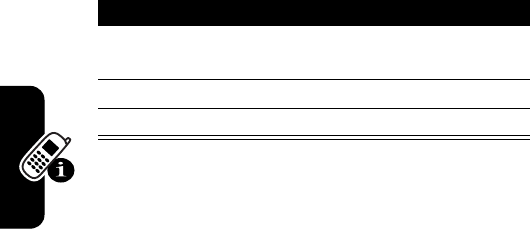
DRAFT
70
Learning to Use Your Phone
If you forget your unlock code, try entering 1234 or the last
4 digits of your phone number. If that does not work, do the
following at the
Enter Unlock Code
prompt:
If you forget your security code, SIM card PIN code,
PIN2 code, or call barring password, contact your
service provider.
Using the Phonebook
This section describes basic phonebook operations. For
more information about using the phonebook, see
page 95.
Storing a Phone Number
Enter a phone number in the home screen, then press
STORE
(
+
) to create a phonebook entry with that number.
Press
DONE
(
-
) to store the number by itself, or fill in the
other fields as necessary to complete the entry.
If you assign a
Name
to the phonebook entry, you can select
MORE
to store another number (for example, a work number)
for the same
Name
.
Press To
1
M
display the unlock code
bypass screen
2
keypad keys enter your security code
3
OK
(
+
) submit your security code

DRAFT
71
Learning to Use Your Phone
Recording a Voice Name
When creating a phonebook entry, scroll to
Voice Name
and
press
RECORD
(
+
). Press and release the voice key and say
the entry’s name (within 2 seconds). When prompted,
press and release the voice key and repeat the name.
Note:
This option is not available for entries stored on the
SIM card.
Setting a Picture ID for a Phonebook
Entry
Press
M
>
Phonebook
> entry, press
M
>
Edit
>
Picture
>picture name.
Also see pages 3 and 34.
Dialing a Number
Press
M
>
Phonebook
, highlight the phonebook entry,
press
N
to call.
Shortcut:
In the phonebook, press a keypad key one or
more times to jump to entries that begin with the key’s
letters.
Voice Dialing a Number
Press and release the voice key, and say the entry’s name
(within 2 seconds).

DRAFT
72
Learning to Use Your Phone
Sorting Phonebook Entries
Press
M
>
Phonebook
, press
M
>
Setup
>
Sort by
, then
select whether you want to sort the phonebook list by
Name
,
Speed No.
,
Voice Name
, or
Email
.
When sorting by name, you can view
All
numbers or just
the
Primary
number for each name. To set the primary
number for a name, see page 98.
Tip:
In
Primary
number view mode, highlight a name
and press
S
left or right to view other numbers
associated with the name.
Viewing Entries By Category
Press
M
>
Phonebook
, press
M
>
Categories
, then select
whether you want to view
All
entries, entries in a
predefined category (
Business
,
Personal
,
General
,
VIPs
), or
entries in a category you created.
To set the category for a phonebook entry, see page 97.

DRAFT
73
Setting Up Your Phone
Setting Up Your Phone
Setting a Ring Style
You can set the following ring style profiles on your phone:
Each profile uses a different set of ring tone alerts or
vibration alerts to notify you of incoming calls, text
messages, and other events. The
Silent
setting silences
your phone until you set another ring style.
To set a ring style:
The ring style indicator shows the current ring style setting
(see page 49).
y
Loud
z
Soft
|
Vibrate
†
Vibe & Ring
}
Vibe then Ring
{
Silent
Find the Feature
M
>
Settings
>
Ring Styles
>
Style
> style name
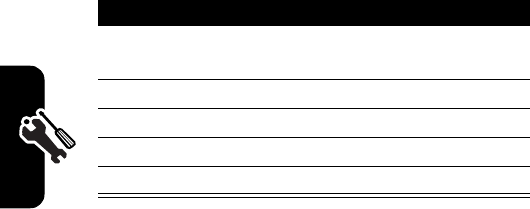
DRAFT
74
Setting Up Your Phone
Changing the Call Alert
You can change the alert that a ring style uses to notify you
of incoming calls or other events. Any changes you make
are saved to the ring style profile.
Note:
Style represents the current ring style. You cannot
set an alert for the
Silent
ring style setting.
The ring style profile contains additional settings for other
events, and settings for ringer ID, ringer and keypad
volume. You can change ring style profile settings as
desired to personalize the ring style.
Setting the Time and Date
You must set the time and date to use the datebook.
Find the Feature
M
>
Settings
>
Ring Styles
>Style
Detail
Press To
1
S
scroll to
Calls
(scroll to
Line 1
or
Line 2
for dual-line phones)
2
CHANGE
(
+
) select the event
3
S
scroll to the alert you want
4
SELECT
(
+
) select the alert
5
BACK
(
-
) save the alert setting
Find the Feature
M
>
Settings
>
Initial Setup
>
Time and Date
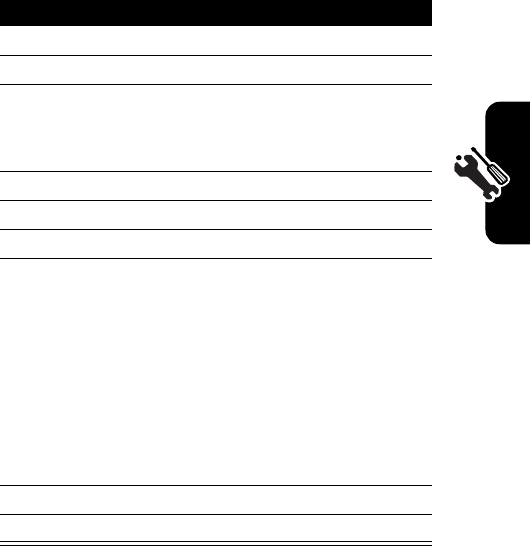
DRAFT
75
Setting Up Your Phone
Setting a Wallpaper Image
Set a photo, picture, or animation as a wallpaper
(background) image in your phone’s home screen. The
wallpaper image appears as a faint watermark in text and
menu displays.
Find the Feature
M
>
Settings
>
Personalize
>
Wallpaper
Press To
1
S
scroll to
Picture
2
CHANGE
(
+
) open the picture viewer
3
S
up or down scroll to a picture/animation
Scroll to
(None)
to turn off the
wallpaper image.
4
SELECT
(
+
) select the image
5
S
scroll to
Layout
6
CHANGE
(
+
) adjust the image layout
7
S
scroll to
Center
,
Tile
, or
Fit-to-screen
Center
places the image in the
center of the display.
Tile
fills the display with
adjacent copies of the image.
Fit-to-screen
resizes the image,
if necessary, to fit the display.
8
SELECT
(
+
) confirm the layout setting
9
BACK
(
-
) save wallpaper settings
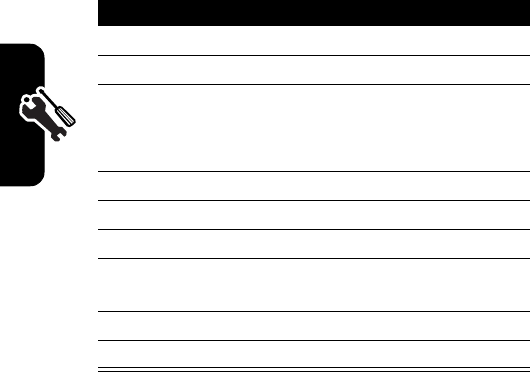
DRAFT
76
Setting Up Your Phone
Setting a Screen Saver Image
Set a photo, picture, or animation as a screen saver image.
The screen saver image displays when the flip is open and
no activity is detected for a specified time. If necessary, the
image shrinks to fill the display. An animation repeats for
one minute, then the first frame of the animation displays.
Tip:
Turn off the screen saver to extend battery life.
Find the Feature
M
>
Settings
>
Personalize
>
Screen Saver
Press To
1
S
scroll to
Picture
2
CHANGE
(
+
) open the picture viewer
3
S
up or down scroll to a picture/animation
Scroll to
(None)
to turn off the
screen saver image.
4
SELECT
(
+
) select the image
5
S
scroll to
Delay
6
CHANGE
(
+
) set the delay interval
7
S
scroll to the inactivity interval
that triggers the screen saver
8
SELECT
(
+
) confirm the delay setting
9
BACK
(
-
) save screen saver settings
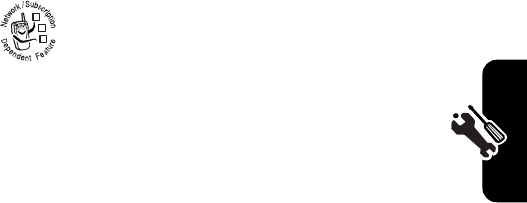
DRAFT
77
Setting Up Your Phone
Changing Phone Skin
Change the look and feel of your phone’s user interface by
selecting a different skin setting.
Your phone displays the new skin.
Setting a Phone Theme
A phone theme is of a grouped set of image and
sound files with a specific theme (such as a
special event or cartoon character) that you can
apply collectively to your phone. Phone themes
typically include a wallpaper image, screen saver
image, and ring tone. Your phone includes several
preloaded themes. You can download and install
additional themes on your phone.
Downloading a Theme
Note:
Normal airtime and/or carrier usage charges apply.
To download a theme from a Web page with the
micro-browser, see page 110. When you install the theme,
you can instantly apply its screen saver, wallpaper, and
ring tone when your phone prompts you to
Apply Theme Now?
Selecting a Theme
You can apply any of the themes installed on your phone.
Find the Feature
M
>
Settings
>
Personalize
>
Skin
>skin
032380o

DRAFT
78
Setting Up Your Phone
Note:
If one of a theme’s components is not available, then
a default setting is applied.
Deleting a Theme
You cannot delete the preloaded themes on your phone.
To delete one or all of the themes that you have
downloaded and installed:
Setting Answer Options
You can use additional, alternative methods to answer an
incoming call.
To activate or deactivate an answer option:
Find the Feature
M
>
Multimedia
>
Themes
>theme
Find the Feature
M
>
Multimedia
>
Themes
>theme
Press To
1
M
open the
Theme
menu
2
S
scroll to
Delete
or
Delete All
3
SELECT
(
+
) select the option
Multi-Key
answer by pressing any key
Open to Answer
answer by opening the flip
Find the Feature
M
>
Settings
>
In-Call Setup
>
Answer Options
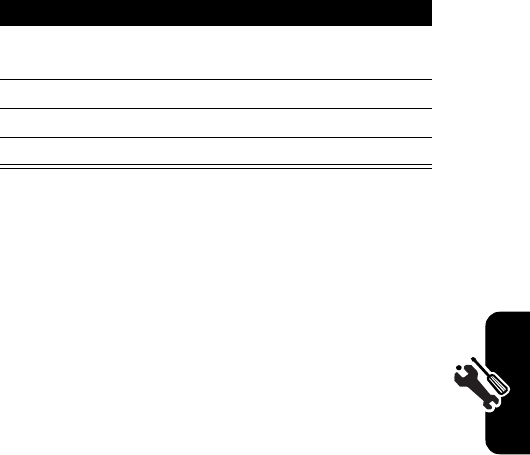
DRAFT
79
Setting Up Your Phone
Setting Display Brightness
Adjusting the Backlight
Set the amount of time that the display and keypad
backlights remain on.
Your phone’s display normally is visible only when the
display backlight is on, or when the display is viewed in
direct sunlight. To extend battery life, the backlight turns off
automatically when no activity is detected for a specified
time. The backlight turns back on when you open the flip or
press any key.
Press To
1
S
scroll to
Multi-Key
or
Open to Answer
2
CHANGE
(
+
) select the option
3
S
scroll to
On
or
Off
4
SELECT
(
+
) confirm the setting
Find the Feature
M
>
Settings
>
Initial Setup
>
Brightness
Find the Feature
M
>
Settings
>
Initial Setup
>
Backlight
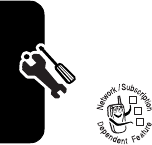
DRAFT
80
Setting Up Your Phone
Setting Display Timeout
To further extend battery life, you can set the display to
turn off (in addition to the backlight) when no activity is
detected for a specified time.
You can set the display to stay on for 1 or 2 minutes, or set
Off
to disable display timeout.
The display turns back on when you open the flip or press
any key.
Storing Your Name and Phone
Number
To store or edit your name and phone number
information on your SIM card:
Shortcut:
Press
M#
from the home screen to view
and edit your name and phone number(s).
If you do not know your phone number, contact your
service provider.
Find the Feature
M
>
Settings
>
Initial Setup
>
Display Timeout
Find the Feature
M
>
Settings
>
Phone Status
>
My Tel. Numbers
032380o
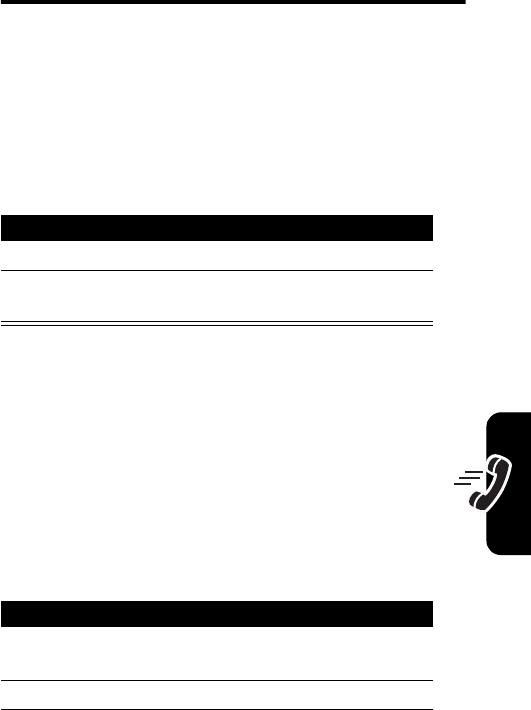
DRAFT
81
Calling Features
Calling Features
For basic instructions on how to make and answer calls,
see page 24.
Turning Off a Call Alert
You can turn off your phone’s incoming call alert before
answering the call.
Viewing Recent Calls
Your phone keeps lists of incoming and outgoing calls,
even for calls that did not connect. The most recent calls
are listed first. The oldest calls are deleted as new calls
are added.
Shortcut:
Press
N
from the home screen to view the
dialed calls list.
Action
1
Press the volume keys to turn off the alert.
2
Open the flip (or press the button on a handsfree
headset) to answer the call.
Find the Feature
M
>
Recent Calls
Press To
1
S
scroll to
Received Calls
or
Dialed Calls
2
SELECT
(
+
) select the list
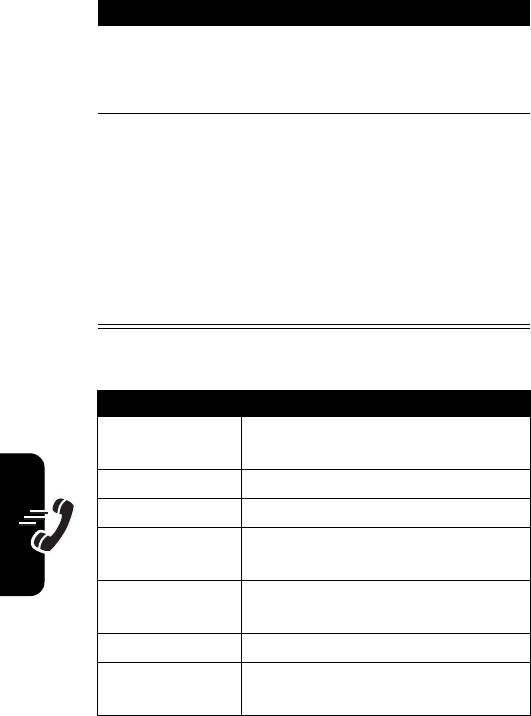
DRAFT
82
Calling Features
The
Last Calls Menu
can include the following options:
3
S
scroll to an entry
Note:
<
means the call
connected.
4
N
or
VIEW
(
+
)
or
M
call the entry’s number
view entry details (such as
time and date of call)
open the
Last Calls Menu
to
perform other procedures
Option Description
Store
Create a phonebook entry with
the number in the
No.
field.
Delete
Delete the entry.
Delete All
Delete all entries in the list.
Hide ID
/
Show ID
Hide or show your caller ID for the
next call.
Send Message
Open a new text message with the
number in the
To
field.
Add Digits
Add digits after the number.
Attach Number
Attach a number from the
phonebook or recent calls lists.
Press To
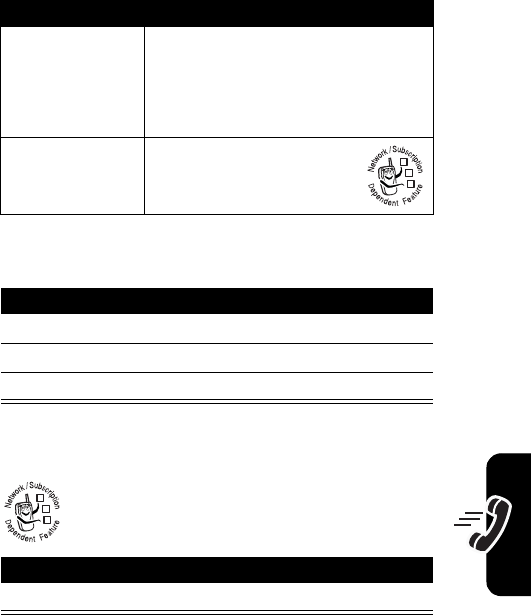
DRAFT
83
Calling Features
Redialing a Number
Using Automatic Redial
When you receive a busy signal, your phone
displays
Call Failed, Number Busy
.
When the call goes through, your phone rings or vibrates
one time, displays
Redial Successful
, and connects the call.
Send Tones
Send the number to the network
as DTMF tones.
Note:
This option displays only
during a call.
Talk then Fax
Talk and then send a fax
in the same call (see
page 106).
Press To
1
N
view the dialed calls list
2
S
scroll to the entry you want to call
3
N
redial the number
Press To
N
or
RETRY
(
+
) redial the number
Option Description
032380o
032380o
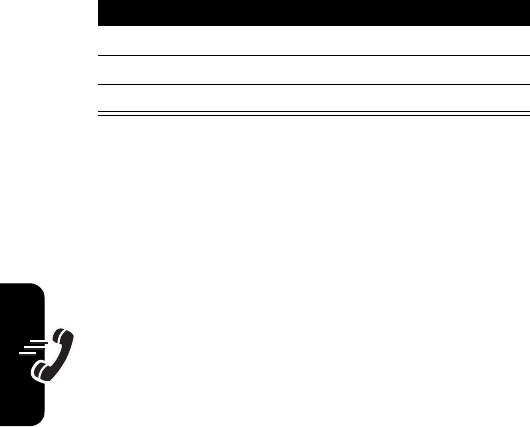
DRAFT
84
Calling Features
Returning an Unanswered Call
Your phone keeps a record of your unanswered calls, and
displays:
•
the missed call indicator
û
•
X Missed Calls
, where
X
is the number of missed calls
Using the Notepad
The most recent set of digits entered on the keypad are
stored in your phone’s notepad memory. This can be a
phone number that you called, or a number that you jot
down during a call, for later use. To retrieve the number
stored in the notepad:
Press To
1
VIEW
(
+
) display the received calls list
2
S
select a call to return
3
N
make the call
Find the Feature
M
>
Recent Calls
>
Notepad
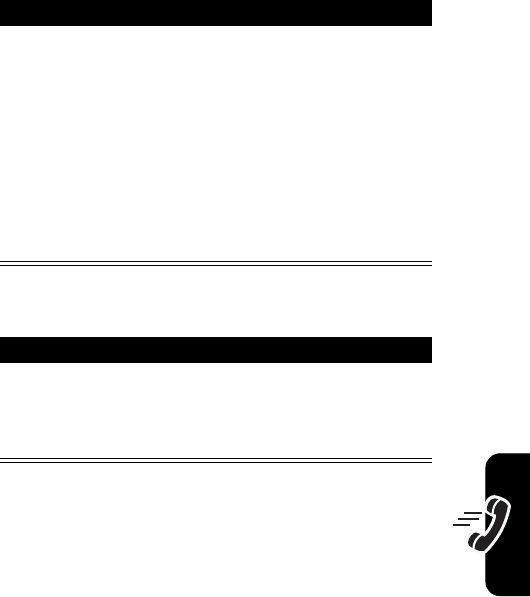
DRAFT
85
Calling Features
Putting a Call On Hold or Mute
Press To
N
or
STORE
(
+
)
or
M
call the number
create a phonebook entry
with the number in the
No.
field
open the
Dialing Menu
to attach
a number or insert a special
character
Press To
M
>
Hold
or
M
>
Mute
put all active calls on hold
mute all active calls
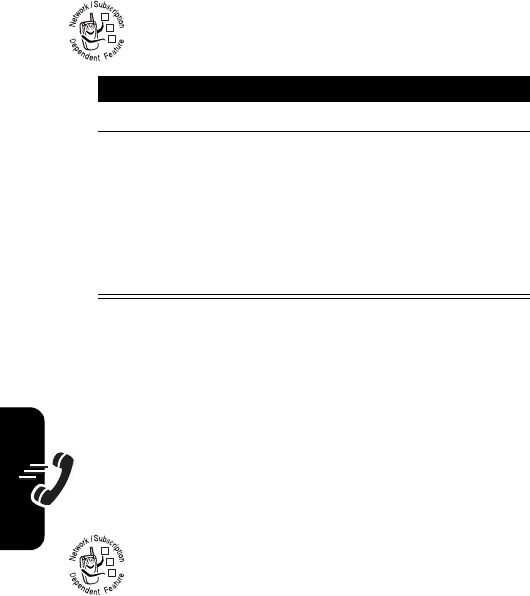
DRAFT
86
Calling Features
Using Call Waiting
When you are on a call, an alert tone sounds to
indicate that you have received a second call.
If necessary, you must turn on call waiting to use the
feature. To turn call waiting on or off:
Using Caller ID (Incoming
Calls)
Calling line identification (caller ID) displays the
phone number for incoming calls in your phone’s
external and internal displays.
The phone displays the caller’s name (and picture ID, if
available) when the name is stored in your phonebook, or
Incoming Call
when caller ID information is not available.
Press To
1
N
answer the new call
2
SWITCH
(
+
)
or
LINK
(
-
)
or
M
>
EndCallOnHold
switch between calls
connect the 2 calls
end the call on hold
Find the Feature
M
>
Settings
>
In-Call Setup
>
Call Waiting
032380o
032380o
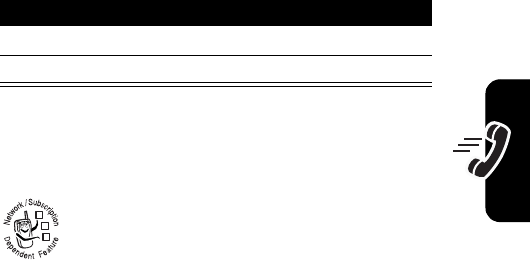
DRAFT
87
Calling Features
You can also set your phone to play a distinctive ringer ID
for specific entries stored in your phonebook. For more
information, see page 95.
Calling an Emergency Number
Your service provider programs one or more emergency
phone numbers, such as 911 or 112, that you can call
under any circumstances, even when your phone is locked
or the SIM card is not inserted.
Note:
Emergency numbers vary by country. Your phone’s
preprogrammed emergency number(s) may not work in all
locations, and sometimes an emergency call cannot be
placed due to network, environmental, or interference
issues.
Dialing International
Numbers
If your phone service includes international
dialing, press and hold
0
to insert the local
international access code (
+
) for the country from
which you are calling. (Inserting
+
enables your
phone to make an international call.) Then press the
keypad keys as usual to dial the country code and phone
number.
Press To
1
keypad keys dial the emergency number
2
N
call the emergency number
032380o
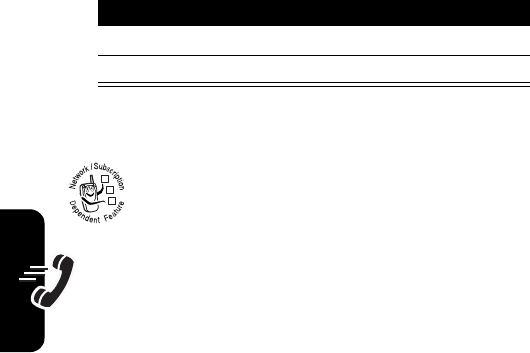
DRAFT
88
Calling Features
Calling With 1-Touch Dial
To call phonebook entries 1 through 9, press and hold the
single-digit speed dial number for one second. (To store
phonebook entries on your phone, see page 70.)
You can set 1-touch dial to call the entries in your phone
memory phonebook or the SIM card phonebook:
Using Voicemail
Voicemail messages that you receive are stored
on the network. To listen to your messages, you
must call your voicemail phone number.
Note:
Your service provider may include additional
information about using this feature.
Listening to Voicemail Messages
The phone calls your voicemail phone number. If no
voicemail number is stored, your phone prompts you to
store a number.
Find the Feature
M
>
Settings
>
Initial Setup
>
1-Touch Dial
Press To
1
S
scroll to the location you want
2
SELECT
(
+
) select the location
Find the Feature
M
>
Messages
>
VoiceMail
032380o

DRAFT
89
Calling Features
Receiving a Voicemail Message
When you receive a voicemail message, your phone
displays the voicemail message indicator
t
and the
New VoiceMail
notification.
The phone calls your voicemail phone number. If no
voicemail number is stored, your phone prompts you to
store a number.
Storing Your Voicemail Number
If necessary, use the following procedure to store your
voicemail phone number on your phone. Usually, your
service provider has already done this for you.
Note:
You cannot store a
p
(pause),
w
(wait), or
n
(number)
character in this number. If you want to store a voicemail
number with these characters, create a phonebook entry
for it. Then, you can use the entry to call your voicemail.
Press To
CALL
(
+
) listen to the message
Find the Feature
M
>
Messages
M
>
VoiceMail Setup
Press To
1
keypad keys enter your voicemail number
2
OK
(
+
) store the number

DRAFT
90
Calling Features
Changing the Active Line
Change the active phone line to make and
receive calls from your other phone number.
Note:
This feature is available only for
dual-line-enabled SIM cards.
The active line indicator in the display shows the current
active phone line (see page 48).
Find the Feature
M
>
Settings
>
Phone Status
>
Active Line
032380o

DRAFT
91
Phone Features
Phone Features
Main Menu
This is the standard main menu layout.
Menu
organization and feature names may vary on your
phone.
Not all features may be available on your phone.
n
Phonebook
s
Recent Calls
• Received Calls
• Dialed Calls
• Notepad
•Call Times
•Call Cost
• Data Times
• Data Volumes
e
Messages
• Create Message
• Email Msgs
• Message Inbox
•Voicemail
•Browser Msgs
• Info Services
•Quick Notes
• Outbox
•Drafts
• MMS Templates
É
Office Tools
• SIM Apps
•Calculator
• Datebook
• Shortcuts
• Voice Dial
• Voice Records
•Alarm Clock
• Dialing Services
• Fixed Dial
• Service Dial
• Quick Dial
• Chat
Q
Games & Apps
á
Web Access
•Browser
• Web Shortcuts
• Stored Pages
•History
•Go To URL
•Browser Setup
• Web Sessions
h
Multimedia
• Videos
•Camera
•Pictures
• Sounds
• Themes
• MotoMixer
ã
IM
w
Settings
(see next page)
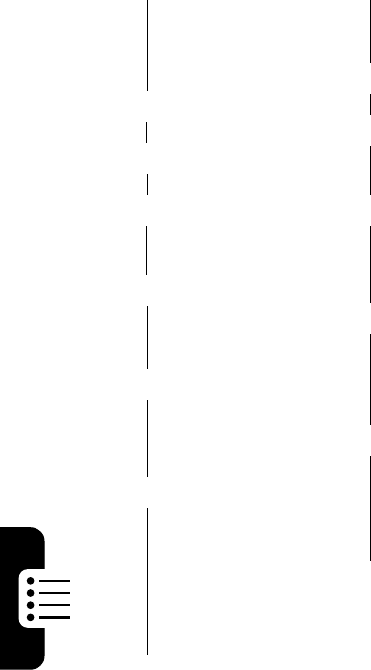
DRAFT
92
Phone Features
Settings Menu
l
Personalize
• Home Screen
•Main Menu
• Color Style
• Greeting
• Wallpaper
• Screen Saver
• Quick Dial
t
Ring Styles
•Style
•Style Detail
L
Connection
• Bluetooth Link
•Sync
ò
Access Point Priority
• Access Point Preferred
• GSM Preferred
• Access Point Only
•GSM Only
H
Call Forward
•Voice Calls
•Fax Calls
• Data Calls
• Cancel All
• Forward Status
U
In-Call Setup
•In-Call Timer
•Call Cost Setup
•My Caller ID
• Talk and Fax
• Answer Options
• Call Waiting
Z
Initial Setup
• Time and Date
• 1-Touch Dial
• Display Timeout
• Backlight
• TTY Setup
•Scroll
• Language
• Brightness
•DTMF
•Master Reset
• Master Clear
m
Phone Status
•My Tel. Numbers
• Credit Info/Available
• Active Line
• Battery Meter
• Other Information
S
Headset
• Auto Answer
• Voice Dial
J
Car Settings
• Auto Answer
• Auto Handsfree
• Power-Off Delay
• Charger Time
j
Network
•New Network
•Network Setup
• Available Networks
• My Network List
• Service Tone
• Call Drop Tone
u
Security
• Phone Lock
• Lock Application
• Fixed Dial
• Call Barring
•SIM PIN
•New Passwords
• Certificate Mgmt
c
Java Settings
• Java System
• Delete All Apps
• App Vibration
• App Volume
• App Priority
• App Backlight
• Set Standby App
• DNS IP
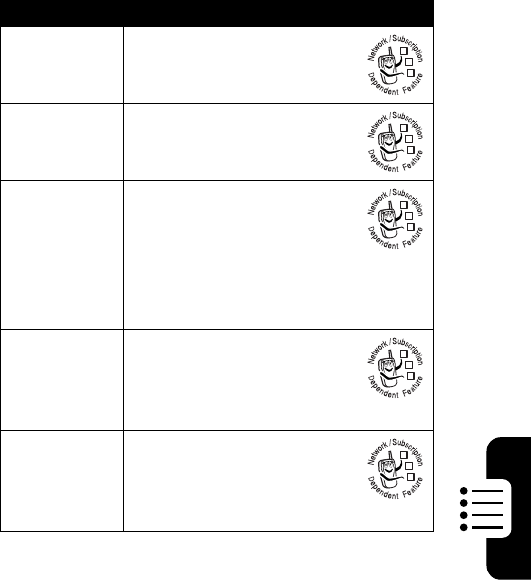
DRAFT
93
Phone Features
Feature Quick Reference
This section helps you locate and use additional phone
features that are not described in this guide.
Calling Features
Feature Description
Conference
Call
During a call:
Dial next number, press
N
,
press
LINK
(
-
).
Transfer a
Call
During a call:
M
>
Transfer
, dial transfer
number, press
N
.
Caller ID
(Outgoing)
Hide or show your caller ID
phone number for the next
outgoing call:
M
>
Settings
>
In-Call Setup
>
My Caller ID
. >
Next Call Only
>
Hide ID
or
Show ID
Attach a
Number
Dial an area code or prefix
for a phonebook number,
then:
M
>
Attach Number
Speed Dial
Speed dial and call a
phonebook entry:
Enter speed dial number,
press
#
, press
N
.
032380o
032380o
032380o
032380o
032380o
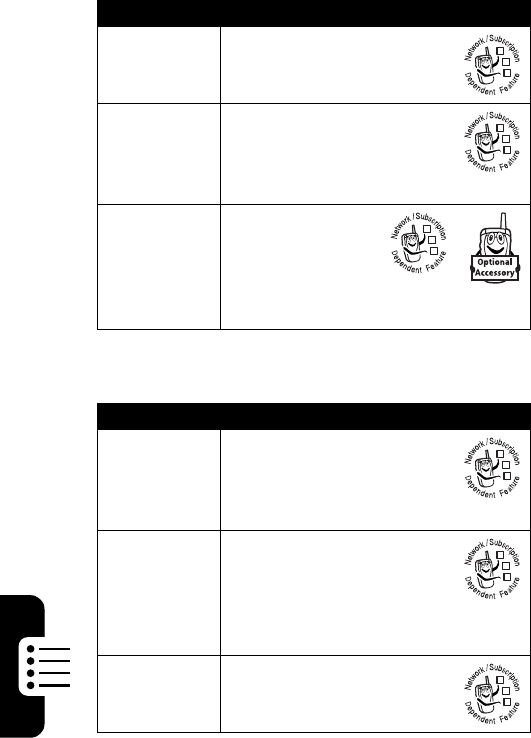
DRAFT
94
Phone Features
Messages
Call
Forwarding
Set up or cancel call
forwarding:
M
>
Settings
>
Call Forward
Call Barring
Restrict outgoing or
incoming calls:
M
>
Settings
>
Security
>
Call Barring
TTY Calls
Set up your phone
for use with an
optional TTY
device:
M
>
Settings
>
Initial Setup
>
TTY Setup
Feature Description
Send Text
Message
Send a text message:
M
>
Messages
>
Create Message
>
New Short Message
Send
Multimedia
Message
Send a multimedia
message:
M
>
Messages
>
Create Message
>
New Multimedia Msg
Send Letter
Send a multimedia letter:
M
>
Messages
>
Create Message
>
New Letter
Feature Description
032380o
032380o
032380o
032380o
032380o
032380o
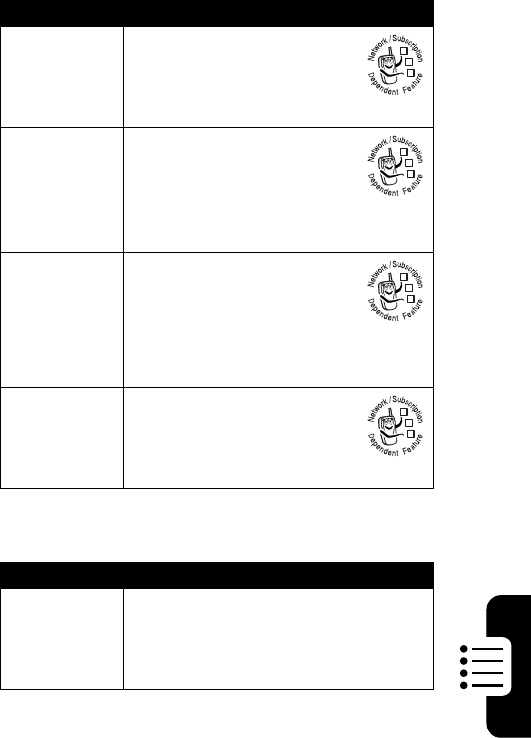
DRAFT
95
Phone Features
Phonebook
Use MMS
Template
Open an MMS template
with preloaded media:
M
>
Messages
>
MMS Templates
Read New
Message
Read a new text or
multimedia message that
you have received:
Press
READ
(
+
) when the
New Message
notification is displayed.
Read old
Messages
Read received messages:
M
>
Messages
>
Message Inbox
Tip:
Press
M
to perform various
operations on the message.
Store
Message
Objects
Go to a multimedia
message page, or highlight
an object in a letter, then:
M
>
Store
Feature Description
Add New
Entry
Add a new entry to the phonebook:
M
>
Phonebook
M
>
New
>
Phone Number
or
Email Address
Feature Description
032380o
032380o
032380o
032380o
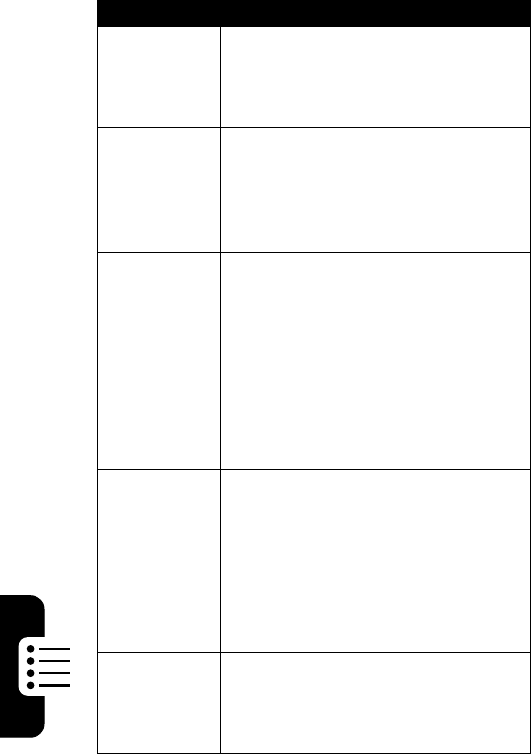
DRAFT
96
Phone Features
Dial Number
Call a number stored in the
phonebook:
M
>
Phonebook
, highlight the
phonebook entry, press
N
to call
Voice Dial
Number
Voice dial a number stored in the
phonebook:
Press and release the voice key, and
say the entry’s name (within
2 seconds).
Set Ringer
ID for Entry
Assign a distinctive ringer alert to an
entry:
M
>
Phonebook
> entry
M
>
Edit
>
Ringer ID
> ringer name
Note:
The
Ringer ID
option is not
available for entries stored on the
SIM card.
To activate ringer IDs, see page 98.
Set Picture
ID for Entry
Assign a photo or picture to a
phonebook entry:
M
>
Phonebook
> entry
M
>
Edit
>
Picture
> picture name
Note:
The
Picture
option is not
available for entries stored on the
SIM card.
Set Picture
ID View
View phonebook entries as text list,
or with picture caller ID photos:
M
>
Phonebook
M
>
Setup
>
View by
> view name
Feature Description
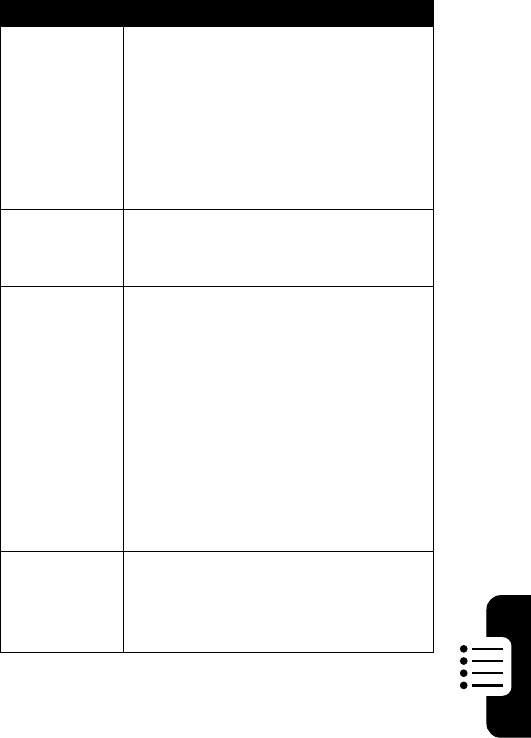
DRAFT
97
Phone Features
Set
Category for
Entry
Set the category for a phonebook
entry:
M
>
Phonebook
> entry
M
>
Edit
>
Category
> category name
Note:
The
Category
option is not
available for entries stored on the
SIM card.
Set
Category
View
Set a phonebook category view:
M
>
Phonebook
M
>
Categories
> category view
Set
Category
Ringer ID
Set a distinctive ring alert (ringer ID)
to sound when you receive calls from
entries in a specific category:
M
>
Phonebook
M
>
Categories
, highlight the
category, press
M
>
Edit
>
Ringer ID
.
Note:
The
Ringer ID
option is not
available for entries stored on the
SIM card.
To activate ringer IDs, see page 98.
Sort
Phonebook
List
Set the order in which phonebook
entries are listed:
M
>
Phonebook
M
>
Setup
>
Sort by
> sort order
Feature Description
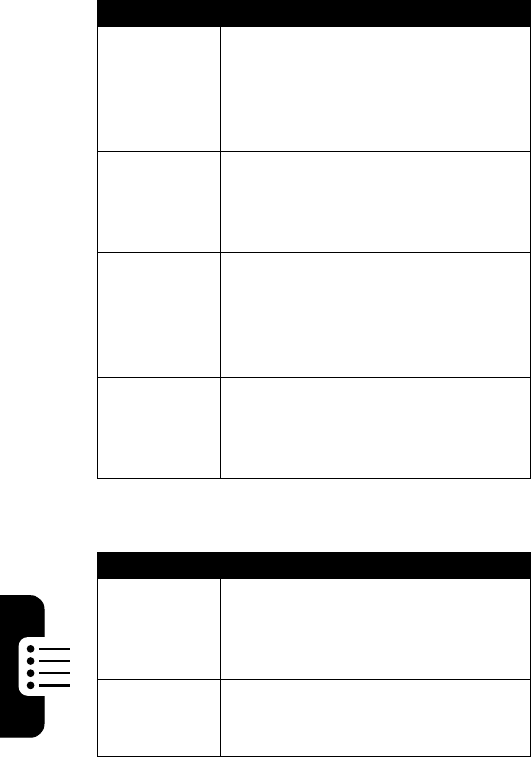
DRAFT
98
Phone Features
Personalizing Features
Set Primary
Number or
Address
Set the primary number for an entry
with multiple numbers:
M
>
Phonebook
, highlight the entry,
press
M
>
Set Primary
>phone number.
Copy
Phonebook
Entry
Copy a phonebook entry between
the phone and SIM card:
M
>
Phonebook
, highlight the entry,
press
M
>
Copy
>
Entries
>
To
Send
Phonebook
Entry to
Another
Device
Send a phonebook entry to another
phone, computer, or device:
M
>
Phonebook
, highlight the entry,
press
M
>
Send
Create
Group
Mailing List
Create a group mailing list as a
phonebook entry:
M
>
Phonebook
M
>
New
>
Mailing List
Feature Description
Activate
Ringer IDs
Activate distinctive ring alerts
assigned to phonebook entries:
M
>
Settings
>
Ring Styles
>Style
Detail
>
Ringer IDs
Ring
Volume
Set ringer volume:
M
>
Settings
>
Ring Styles
>Style
Detail
>
Ring Volume
Feature Description
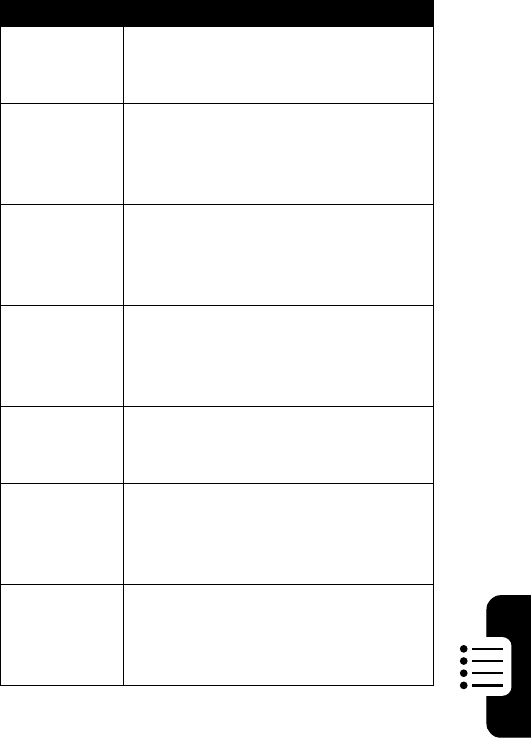
DRAFT
99
Phone Features
Keypad
Volume
Set keypad keypress volume:
M
>
Settings
>
Ring Styles
>Style
Detail
>
Key Volume
Reminders
Set reminder alerts for messages
that you receive:
M
>
Settings
>
Ring Styles
>Style
Detail
>
Reminders
Clock View
Display an analog clock or digital
time readout in the home screen:
M
>
Settings
>
Personalize
>
Home Screen
>
Clock
Menu View
Display the main menu as graphic
icons or as a text-based list:
M
>
Settings
>
Personalize
>
Main Menu
>
View
Main Menu
Reorder your phone’s main menu:
M
>
Settings
>
Personalize
>
Main Menu
>
Reorder
Show or
Hide Menu
Icons
Show or hide menu feature icons in
the home screen:
M
>
Settings
>
Personalize
>
Home Screen
>
Home Keys
>
Icons
Change Soft
Keys &
Menu Icons
Change soft key labels and menu
feature icons in the home screen
M
>
Settings
>
Personalize
>
Home Screen
>
Home Keys
Feature Description
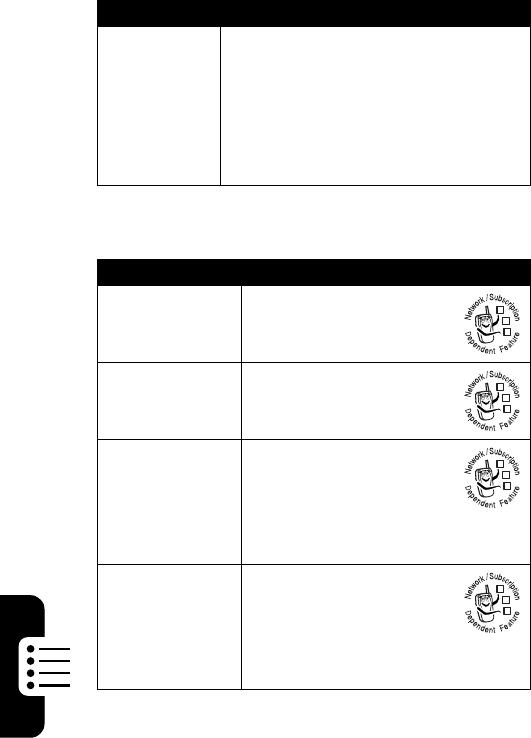
DRAFT
100
Phone Features
Instant Messaging
Shortcuts
Create a shortcut to a menu item:
Highlight the menu item, then press
and hold
M
.
Select a shortcut:
M
>
Office Tools
>
Shortcuts
>shortcut name
Feature Description
Log In
Log in to instant
messaging:
M
>
IM
>
Log In
Find Others
Online
After you sign on:
Select
Contact List
to see a
list of other users.
Start
Conversation
Start a conversation:
From your
Contact List
,
highlight a name in
Online Contacts
, press
SEND IM
(
+
).
Open Active
Conversation
Open a conversation in
progress:
From your
Contact List
,
highlight a name in
Conversations
, press
VIEW
(
+
).
Feature Description
032380o
032380o
032380o
032380o
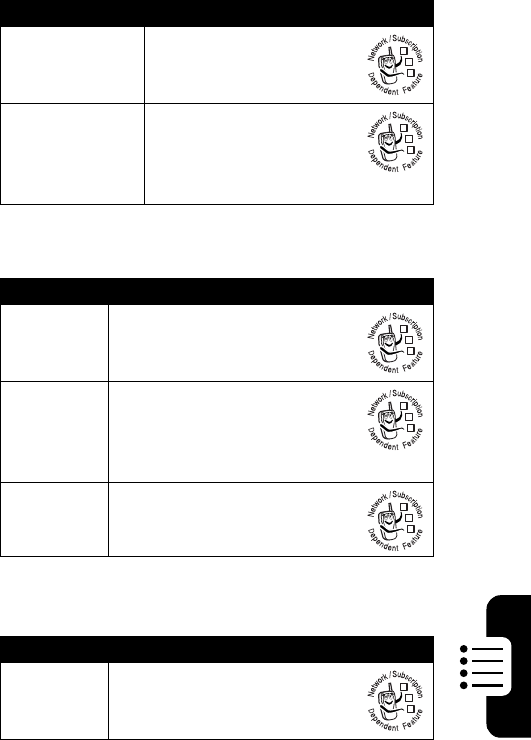
DRAFT
101
Phone Features
Chat
Email
End
Conversation
From the conversation
display:
M
>
End Conversation
Log Out
Log out of instant
messaging:
Select
Log Out
from the
IM Online
menu.
Feature Description
Start Chat
Start a new chat session:
M
>
Chat
M
>
New Chat
Receive
Chat
Request
When you receive a chat
request:
Press
ACCEPT
(
+
) or
IGNORE
(
-
).
End Chat
During a chat session:
M
>
End Chat
Feature Description
Send
Email
Message
Send an email message:
M
>
Messages
>
Create Message
>
New Email
Feature Description
032380o
032380o
032380o
032380o
032380o
032380o
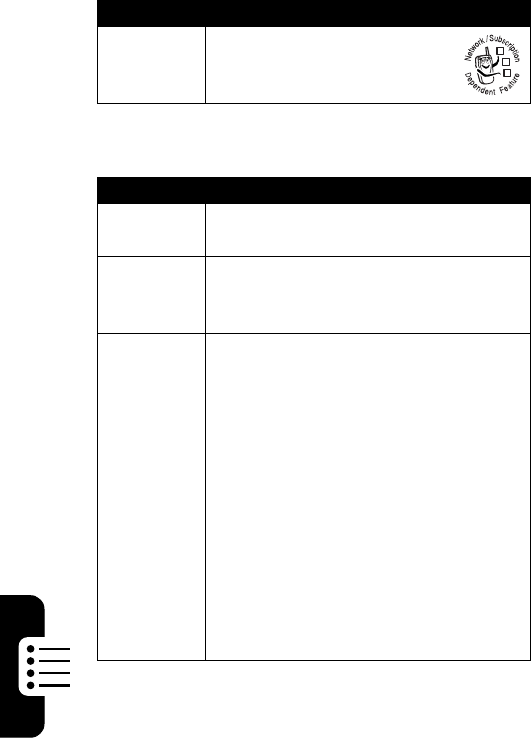
DRAFT
102
Phone Features
Menu Features
Read
Email
Message
Read a new email message
that you have received:
Press
READ
(
+
).
Feature Description
Language
Set menu language:
M
>
Settings
>
Initial Setup
>
Language
Master
Reset
Reset all options except unlock code,
security code, and lifetime timer:
M
>
Settings
>
Initial Setup
>
Master Reset
Master
Clear
Clear all user settings and entries
except SIM card information, erase all
downloaded pictures and sound files,
reset all options except unlock code,
security code, and lifetime timer:
M
>
Settings
>
Initial Setup
>
Master Clear
Caution:
Master clear
erases all
user-entered information
(including
phonebook and datebook entries)
and
user-downloaded content
(including
photos and sounds) stored in your
phone’s memory. After you erase the
information, you cannot recover it.
Feature Description
032380o
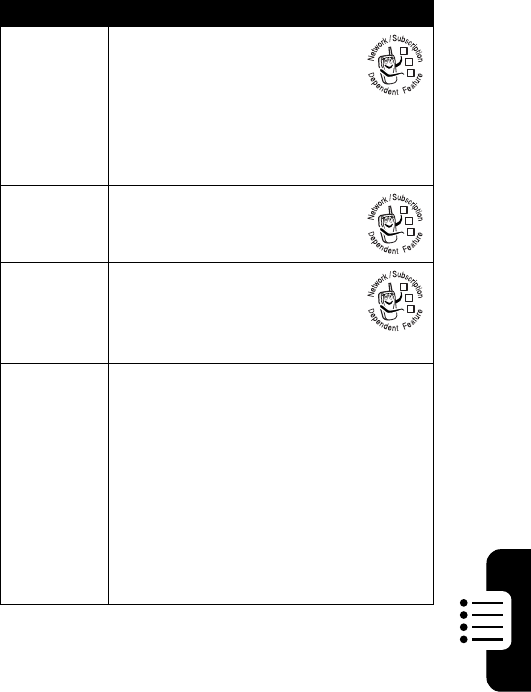
DRAFT
103
Phone Features
Special Dialing Features
Feature Description
Fixed Dial
Turn fixed dialing on or off:
M
>
Settings
>
Security
>
Fixed Dial
Use the fixed dial list:
M
>
Office Tools
>
Dialing Services
>
Fixed Dial
Service
Dial
Dial service phone numbers:
M
>
Office Tools
>
Dialing Services
>
Service Dial
Quick Dial
Dial preprogrammed phone
numbers:
M
>
Office Tools
>
Dialing Services
>
Quick Dial
DTMF
Tones
Activate DTMF tones:
M
>
Settings
>
Initial Setup
>
DTMF
Send DTMF tones during a call:
Press number keys.
Send stored numbers as DTMF tones
during a call:
Highlight a number in the phonebook
or recent calls lists, then press
M
>
Send Tones
.
032380o
032380o
032380o
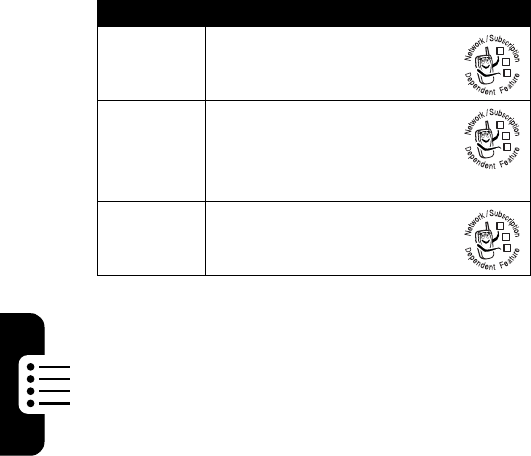
DRAFT
104
Phone Features
Call Monitoring
Network connection time
is the elapsed time from the
moment you connect to your service provider's network to
the moment you end the call by pressing
O
. This time
includes busy signals and ringing.
The amount of network connection time you track on
your resettable timer may not equal the amount of time
for which you are billed by your service provider. For
billing information, please contact your service
provider directly.
Handsfree Features
Note:
The use of wireless devices and their
accessories may be prohibited or restricted in certain
Feature Description
Call Times
View call timers:
M
>
Recent Calls
>
Call Times
In-Call
Timer
Display time or cost
information during a call:
M
>
Settings
>
In-Call Setup
>
In-Call Timer
Call Cost
View call cost trackers:
M
>
Recent Calls
>
Call Cost
032380o
032380o
032380o
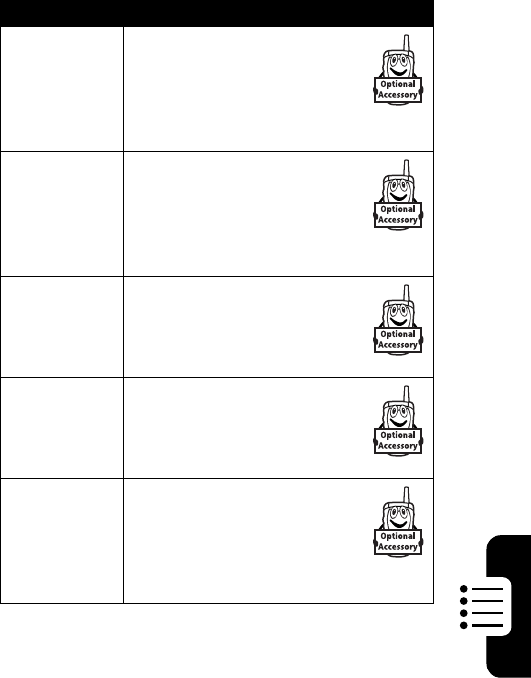
DRAFT
105
Phone Features
areas. Always obey the laws and regulations on the use of
these products.
Feature Description
Speaker-
phone
Activate a connected
external speakerphone
during a call:
Press
SPEAKER
(
+
) (if
available) or
M
>
Spkrphone On
.
Auto
Answer
(car kit or
headset)
Automatically answer calls
when connected to a car kit
or headset:
M
>
Settings
>
Car Settings
or
Headset
>
Auto Answer
Voice Dial
(headset)
Enable voice dial with
headset send/end key:
M
>
Settings
>
Headset
>
Voice Dial
Auto
Handsfree
(car kit)
Automatically route calls to a
car kit when connected:
M
>
Settings
>
Car Settings
>
Auto Handsfree
Power-Off
Delay
(car kit)
Set the phone to stay on for
a period of time after the
ignition is switched off:
M
>
Settings
>
Car Settings
>
Power-Off Delay
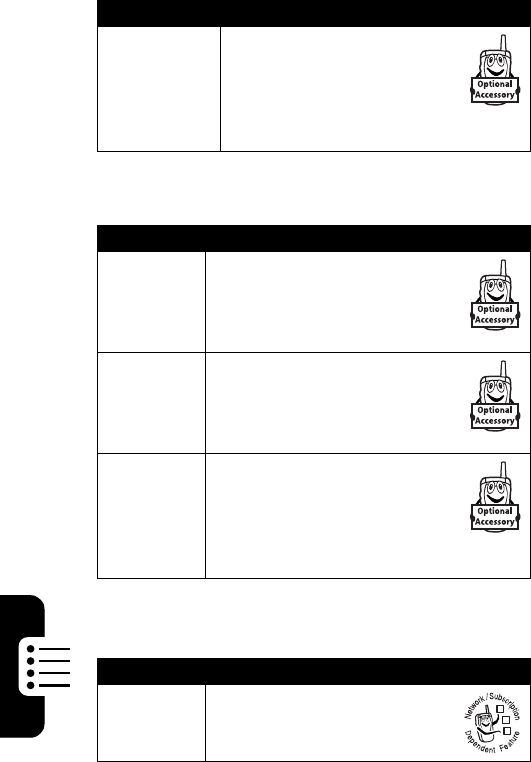
DRAFT
106
Phone Features
Data and Fax Calls
Network Features
Charger
Time
(car kit)
Charge the phone for a
period of time after the
ignition is switched off:
M
>
Settings
>
Car Settings
>
Charger Time
Feature Description
Send Data
or Fax
Connect your phone to the
device, then place the call
through the device
application.
Receive
Data or
Fax
Connect your phone to the
device, then answer the call
through the device
application.
Talk Then
Fax
Connect your phone to the
device, enter the number,
press
M
>
Dialing Menu
>
Talk Then Fax
, then press
N
to
make the call.
Feature Description
Network
Settings
View network information and
adjust network settings:
M
>
Settings
>
Network
Feature Description
032380o
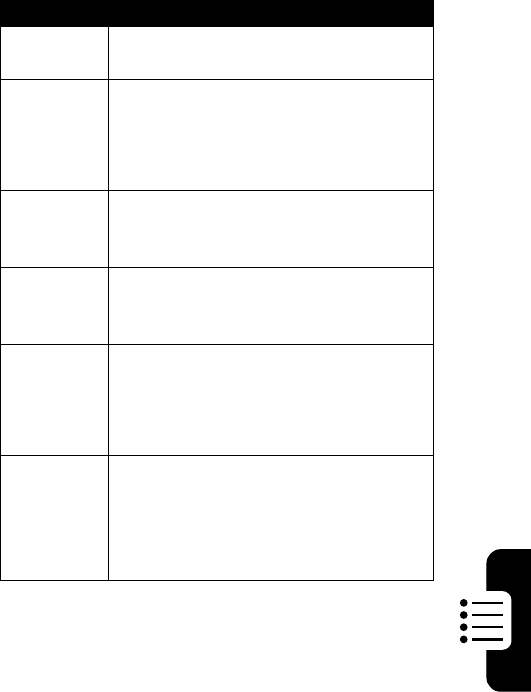
DRAFT
107
Phone Features
Personal Organizer Features
Feature Description
Set Alarm
Set an alarm:
M
>
Office Tools
>
Alarm Clock
Turn Off
Alarm
Turn off alarm:
Press
DISABLE
(
-
) or
O
Set 8-minute delay:
Press
SNOOZE
(
+
)
Add New
Datebook
Event
Add a new event to the datebook:
M
>
Office Tools
>
Datebook
, highlight
the day, press
C
, press
M
>
New
View
Datebook
Event
View or edit event details:
M
>
Office Tools
>
Datebook
, highlight
the day, press
C
, press
VIEW
(
+
)
Event
Reminder
View a datebook event reminder:
VIEW
(
+
)
Dismiss an event reminder:
EXIT
(
-
)
Send
Datebook
Event to
Another
Device
Send a datebook event to another
phone, computer, or device:
M
>
Office Tools
>
Datebook
, highlight
the day, press
C
, highlight the event,
press
M
>
Send
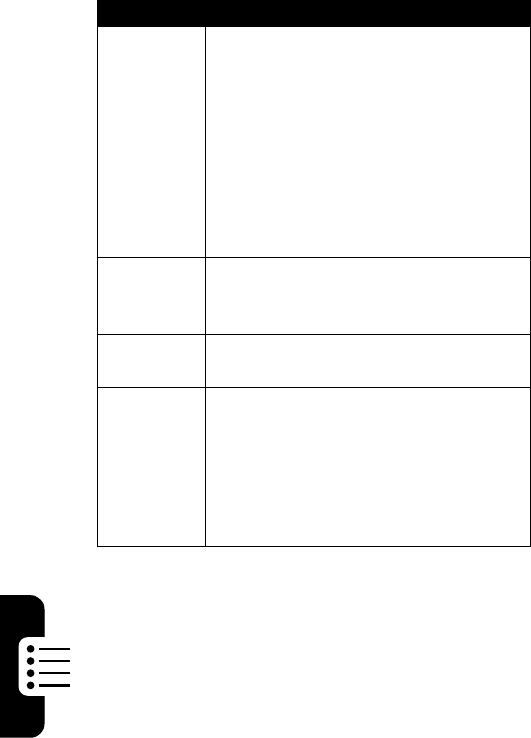
DRAFT
108
Phone Features
Create
Voice
Record
Create a voice record:
Press and hold voice key, speak into
the phone, release voice key.
Note:
Recording of phone calls is
subject to varying State and Federal
laws regarding privacy and recording
of phone conversations. Always obey
the laws and regulations on the use of
this feature.
Play Voice
Record
Play back a voice record:
M
>
Office Tools
>
Voice Records
>voice record
Calculator
Calculate numbers:
M
>
Office Tools
>
Calculator
Currency
Converter
Convert currency:
M
>
Office Tools
>
Calculator
M
>
Exchange Rate
Enter exchange rate, press
OK
(
+
),
enter amount, press
M
>
Convert Currency
.
Feature Description
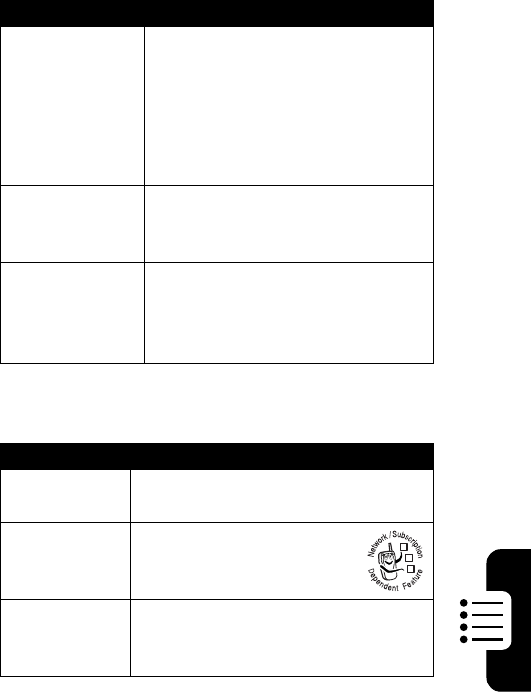
DRAFT
109
Phone Features
Security
News and Entertainment
Feature Description
SIM PIN
Lock or unlock the SIM card:
M
>
Settings
>
Security
>
SIM PIN
Caution:
If you enter an incorrect
PIN code 3 times in a row, your
SIM card is disabled and your
phone displays
SIM Blocked
.
Lock
Application
Lock phone applications:
M
>
Settings
>
Security
>
Lock Application
Certificate
Management
Enable or disable security
certificates stored on your phone:
M
>
Settings
>
Security
>
Certificate Mgmt
Feature Description
Manage
Video Clips
Manage video clips:
M
>
Multimedia
>
Videos
Manage
Pictures
Manage pictures and
animations:
M
>
Multimedia
>
Pictures
Manage
Sounds
Manage ring tones and music that
you have downloaded or composed:
M
>
Multimedia
>
Sounds
032380o
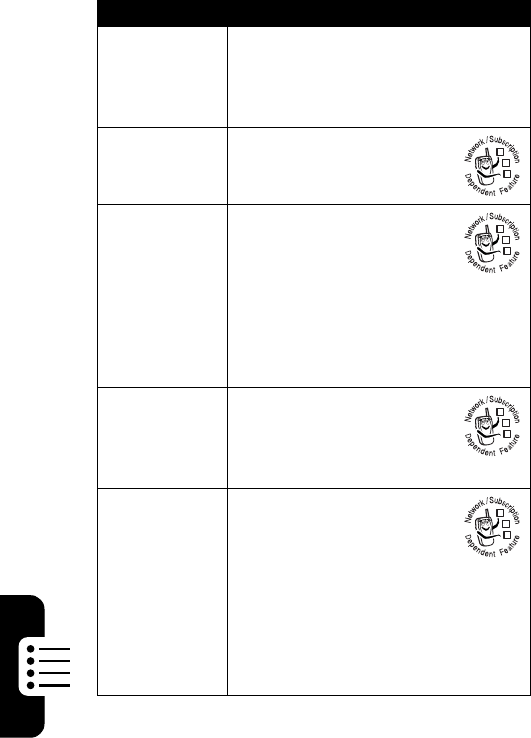
DRAFT
110
Phone Features
Edit Sounds
With
MotoMixer
Edit MIDI-based sound files that you
can use with your phone:
M
>
Multimedia
>
MotoMixer
>
[New Mix]
or mix file name
Start Micro-
Browser
Start a micro-browser
session:
M
>
Web Access
>
Browser
Download
Objects from
Web Page
Download a picture,
sound, or phone theme
from a Web page:
Highlight the file, press
SELECT
(
+
), press
STORE
(
+
).
Note:
Normal airtime and/or carrier
usage charges apply.
Web
Sessions
Select or create a Web
session:
M
>
Web Access
>
Web Sessions
Download
Game or
Application
Download a Java™ game
or application with the
micro-browser:
M
>
Web Access
>
Browser
,
highlight the application, press
SELECT
(
+
), press
DWNLOAD
(
+
).
Note:
Normal airtime and/or carrier
usage charges apply.
Feature Description
032380o
032380o
032380o
032380o
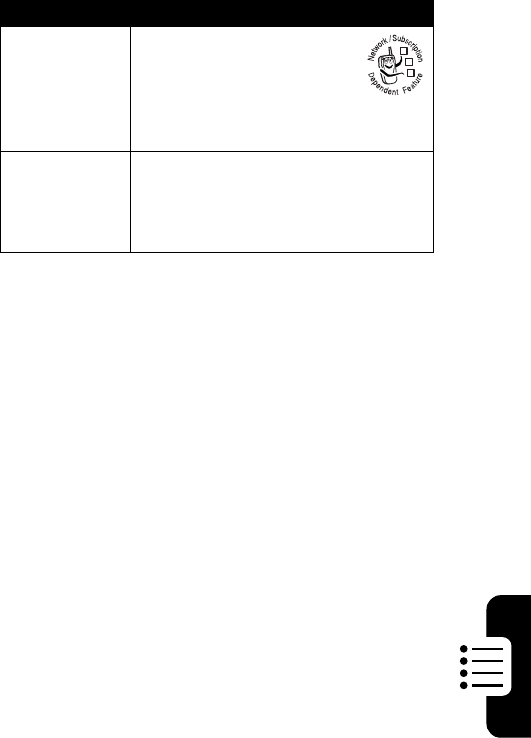
DRAFT
111
Phone Features
Start Game
or
Application
Launch a Java game or
application:
M
>
Games & Apps
,
highlight the application,
press
SELECT
(
+
).
Create Ring
Tones
Create ring tones that you can use
with your phone:
M
>
Multimedia
>
Sounds
>
[New iMelody]
Feature Description
032380o

DRAFT
112
Troubleshooting
Troubleshooting
If you have questions or need assistance, we’re here to
help. Go to
www.motorola.com/consumer/support
,
where you can select from a number of customer care
options. You can also contact the Motorola Customer
Support Center at 1-800-331-6456 (United States),
1-888-390-6456 (TTY/TDD United States for hearing
impaired), or 1-800-461-4575 (Canada).

DRAFT
113
S pe c ific A bs orpt io n R a te Da ta
T he model wireles s phone meets the government’s requirements for
ex pos ure to radio waves .
Your wireless phone is a radio transmitter and receiver. It is des igned and
manufactured not to exceed limits for exposure to radio frequency (R F)
energy set by the Federal C ommunications C ommis sion (F C C) of the U.S .
G overnment and by the C anadian regulatory authorities . T hes e limits are
part of comprehensive guidelines and establish permitted levels of R F
energy for the general population. The guidelines are based on standards
that were developed by independent scientific organizations through
periodic and thorough evaluation of scientific studies. T he standards
include a s ubstantial s afety margin designed to ass ure the safety of all
pers ons, regardless of age or health.
T he exposure standard for wireles s mobile phones employs a unit of
measurement known as the S pecific Absorption R ate, or S AR . The S AR
limit set by the F C C and by the C anadian regulatory authorities is
1.6 W/kg.
1
Tests for S AR are conducted using standard operating
positions accepted by the F C C and by Industry C anada with the phone
transmitting at its highest certified power level in all tested frequency
bands. Although the S AR is determined at the highest certified power
level, the actual S AR level of the phone while operating can be well below
the maximum value. T his is because the phone is designed to operate at
multiple power levels s o as to us e only the power required to reach the
network. In general, the closer you are to a wireless base station, the
lower the power output.
B efore a phone model is available for sale to the public in the U.S . and
C anada, it mus t be tested and certified to the FC C and Industry C anada
that it does not exceed the limit es tablished by each government for safe
exposure. The tests are performed in positions and locations (e.g., at the
ear and worn on the body) reported to the F C C and available for review by
Industry C anada. The highest S AR value for this model phone when
DRAFT
114
tes ted for use at the ear is 1.02 W/kg, and when worn on the body, as
described in this user guide, is 0.50 W /kg. (B ody-worn measurements
differ among phone models, depending upon available access ories and
regulatory requirements ).
2
While there may be differences between the S AR levels of various phones
and at various positions, they all meet the governmental requirements for
safe exposure. P leas e note that improvements to this product model
could cause differences in the S AR value for later products; in all cases,
products are designed to be within the guidelines.
Additional information on S pecific Absorption R ates (S AR ) can be found
on the C ellular Telecommunications & Internet Association (C TIA) Web
site:
http://www.phonefacts.net
or the C anadian Wireles s Telecommunications Association (C WTA) Web
site:
http://www.cwta.ca
1. In the United S tates and C anada, the S AR limit for mobile phones used by
the public is 1.6 watts/kg (W/kg) averaged over one gram of tissue. The
standard inc orporates a subs tantial margin of safety to give additional
protec tion for the public and to acc ount for any variations in meas urements.
2. The S AR information inc ludes the Motorola testing protocol, assess ment
procedure, and mea s urement uncertainty range for this produc t.

DRAFT
115
Index
A
access point connection 26
accessories 18, 40, 66, 94,
104
accessory connector port 1
active line indicator 48
active line, changing 90
alarm clock 107
alert
creating 111
reminder 99
setting 24, 65, 73, 74
turning off 24, 81
animation 36, 75, 76, 109
answering a call 25, 78
attach number 82, 93
B
backlight 79
barring calls 94
battery 21, 22
battery level indicator 49
battery life, extending 19,
41, 46, 76, 79, 80
Bluetooth connection
indicator 47
Bluetooth wireless 2, 26,
40, 98, 107
bonding. See Bluetooth
wireless
brightness 79
browser. See micro-browser
C
calculator 108
call
alert, turning off 24, 81
answering 25, 78
barring 94
call waiting 86
costs 104
dialing 24, 71, 96
emergency number 87
ending 24, 25
forwarding 94
hold 85
international dialing 87
making 24, 71, 96
mute 85
receiving 25
returning 66, 84
talk then fax 83
timers 104
transferring 93
DRAFT
116
call barring password 67
Call Failed, Number Busy
message 83
call forward indicator 48
call waiting 86
caller ID 3, 35, 71, 82, 86,
93, 96
camera 2, 3, 29, 34, 45
car kit 104
center select key 1, 50
certificate management
109
character chart 62
chat 101
clock 45, 74, 99
codes 67, 68, 69
conference call 93
CSD indicator 47
cursor 54
customer support 112
D
data call 106
data indicator 47
date, setting 74
datebook 107
dialed calls 81
dialing a number 24
dialing a phone number 71,
96, 103
display
backlight 79
brightness 79
language 102
personalizing 99
skin 77
timeout 80
using 45
download media objects
95, 110
drafts folder 40
DTMF tones 83, 103
E
earpiece volume 24
email 101
email address, storing 95
emergency number 87
end key 1, 24, 25
ending a call 24, 25
Enter Unlock Code
message 69, 70
external display 2, 65
F
fax call 83, 106
fixed dial 103
flip 25, 65, 78
forwarding calls 94
DRAFT
117
G
games 110
GPRS indicator 48
group mailing list 98
H
handsfree speaker 2, 67
handsfree use 104
headset 66, 104
Hide ID feature 82
hold call 85
home keys, personalizing
99
home screen 45
I
IM 100
IM indicators 49
in-call indicator 48
Incoming Call message 86
indicators 45, 47, 48, 49,
50, 56, 84, 89
instant messaging. See IM
international access code
87
iTAP text entry mode 56
J
Java applications 110
Java midlet indicator 49
K
keypad 78, 99
keys 1, 17, 23, 24, 25, 46,
50, 65, 66, 99
L
language 102
left soft key 1, 46, 99
line, changing 90
linking. See Bluetooth
wireless
location indicator 50
lock
application 109
phone 68
SIM card 109
Low Battery message 49
M
making a call 24, 71, 96
master clear 102
master reset 102
menu
entering text 53
icons, changing in home
screen 99
language 102
navigating 51
personalizing 99
selecting feature 52
menu icons 45, 99
DRAFT
118
menu indicator 45
menu key 1, 17
message 45, 94, 95, 99
message indicator 49
micro-browser 45, 110
missed call indicator 84
Missed Calls message 66,
84
MMS, defined 36
MotoMixer 110
multimedia letter 94
multimedia message 3, 36,
94, 95
music 109, 110
mute call 85
my telephone number 25,
80
N
navigation key 1, 17, 50
network settings 106
notepad 84
number. See phone number
numeric entry mode 63
O
object exchange 42, 43
1-touch dial 88
open to answer 78
optional accessory 18
optional feature 18
P
pairing. See Bluetooth
wireless
passwords. See codes
personal area network 26
personal area network
indicator 48
phone
illustration 1, 2
turning on/off 23
unlocking 68, 69
phone number
active line, changing 90
redialing 83
storing in phonebook 95
storing your number 80
viewing your number 25
phone theme 77
phonebook 45, 70, 82, 88,
93
photo 3, 34, 36, 71, 75, 76,
96, 109
picture 36, 75, 76, 109
picture ID 3, 35, 71, 86, 96
PIN code 67, 109
PIN2 code 67
power key 1, 23
predictive text entry 56
Q
quick dial 103
DRAFT
119
R
received calls 81
recent calls 81, 82
redial 83
reminders 99
right soft key 1, 46, 99
ring style indicators 49
ring style, setting 24, 65, 73
ring tone 109, 110, 111
ringer ID 96, 97, 98
ringer volume 24, 98
roam indicator 48
S
screen saver 76
security code 67, 69
send key 1, 24, 25
service dial 103
shortcuts 100
Show ID feature 82
signal strength indicator 48
SIM Blocked message 23,
109
SIM card
installing 18
locking 109
PIN code 67, 109
PIN2 code 67
precautions 19
service dial 103
SIM Blocked message
109
skin 77
smart key 1, 65, 66, 99
soft keys 1, 46, 99
song 109, 110
sound 36, 109, 110, 111
speakerphone 104
speed dial 93
Spkrphone On message 67
symbol chart 64
symbol entry mode 63
T
talk then fax call 83
tap text entry mode 59
telephone number. See
phone number
text entry 53
text indicators 56
theme 77
time, setting 74
timers 104
transfer a call 93
travel charger 22
troubleshooting 112
TTY device 94
DRAFT
120
U
unanswered call 66, 84
unlock
application 109
phone 68
unlock code 67, 68, 69
V
video clip 3, 29, 36, 109
voice dial 71, 96, 105
voice key 1, 71
voice name, recording 71
voice record 36, 108
voicemail 88
voicemail message indicator
49, 89
volume
earpiece 24
keypad 99
ringer 24, 98
volume keys 1, 24, 65, 66
W
wallpaper 75
Web pages 110
Web sessions 110
U.S. patent Re. 34,976

motorola.com